#i saw some of these statues in person at the art institute of chicago and they should be in the hands of descendants and enshrined tbh
Text
Female Icons, Ancestral Mothers

I thought some of my sister Goddess tumbloggers might enjoy this -- I have this poster in my house and I really love it, I got it here from the amazing Suppressed Histories Archive.
#goddess#herstory#suppressed histories archive#ancestral mothers#female icons#goddess blogging#herstory blogging#max dashu who runs suppressed histories archive is great if you don't follow her i highly recommend her patreon or 'matreon' and her SHA fb#yes i know links fuck with the algorithm idc this is for my followers <3#i saw some of these statues in person at the art institute of chicago and they should be in the hands of descendants and enshrined tbh#a plaque just does not cut it#when i saw certain ones it hit me so painfully that they are stolen#but anyway this poster is one of my strong anti dysphoria medicines.. i love to see all the weird female shapes our ancestors carved#just realized the link just opened the image lol fixed it
154 notes
·
View notes
Text
oh geez guess who remembered they can actually explain the thought process behind Whatever The Fuck The Rothko Comic Is look don't ask me let's just let me talk about art for a minute that's probably easiest
"nooo aha dont write a fucking novel about your favorite piece of art haha youre so sexy" shut up! my meat is huge. AND i'm sexy as hell. thank you.
let's talk about Clothespin by Claes Oldenburg.
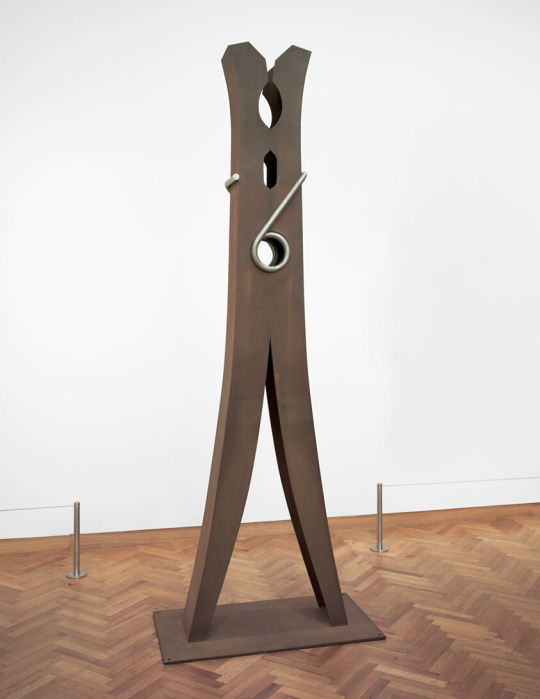
my favorite piece of art of all time. this isn't a joke actually. this 10 foot tall clothespin has made me feel just about every emotion in existence. there's a larger (i think about 45 ft?) version in philadelphia somewhere that i'm aware of but i haven't actually gotten to see that one in person (maybe someday) so we're just going to be talking about the smaller one. which is still quite large. i think to actually explain myself and this one i need to take you through my history with it and how i originally saw it, because that really plays a lot into how i view it. maybe more so than the actual piece itself.
i'm just going from memory here so bear with me... this story takes place back in middle school when i lived in the midwest. i was a young dumb kid who liked drawing stuff so my parents would just sign me up for whatever art classes they could find (i took botanical art with a bunch of middle aged ladies once which fucked severely) and, since we were in the burbs just a train ride away from chicago, one of the options available was to take kids classes at the art institute. so i took some digital art classes there.
enter me: 12 years old and just wanting to learn how to draw anime girls on the computer. at this point i have not thought about art beyond knowing superficially that i enjoy Some Paintings and that certain narrative works have whipped my nuts off and sometimes i would look at pics on deviantart and get emotions i was unable to describe but i have not really, at this point in the story, thought to question why i feel that way.
there's one other important thing to know to make this whole experience make sense. the timing of me attending these classes was right around when the art institute opened up their modern wing! brand new wing + taking a digital art class = i spent so much time in there i cannot even begin to describe it. i wouldn't necessarily say that i like modern art more or less than anything else... but i can say that by sheer volume alone, no question, it is the majority of museum art i have consumed.
anyway, for those unfamiliar: the art institute has two entrances (well, that i know of). there's the main one with the lions that you've probably seen in ferris bueller's day off, and the second one is through the modern wing. here are some pictures i found online showing what the main hall is kind of like:


that glass wall in the far part of the picture is where the doors are. it's a really nice space; there are galleries both upstairs and downstairs. this is also the same place that i saw Untitled (Portrait of Ross in LA) but that's really neither here nor there. i've just seen it brought up before here and thought i would mention that it was a very cool experience. one of those things again where i saw it way before i could comprehend why it made me feel the emotions it made me feel... and then i got hit with The Understanding years later like a cartoon anvil. i couldn't actually find any pics in the 5 minutes i had to spend on google with Clothespin actually displayed, but here it is with a different statue in roughly, to my recollection, the same place:
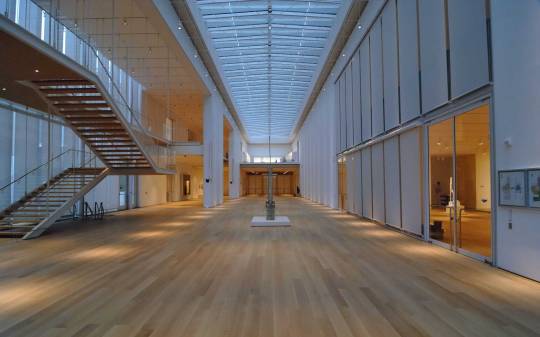
that is a really dramatic place to put a sculpture.
okay well, anyway, the first time i saw this piece, i did not think it would rock my shit. i actually thought it was just kind of funny. i still remember it - our little group was walking to go take a look at a specific piece and of course, had to go through the lobby to get there. i saw Clothespin for the first time and went "haha, that one's kinda funny, i wonder what that means?" and someone shot back "i don't know, maybe a giant lost it doing laundry." that exchange tickled me so much that i spent the rest of the day and into the next week thinking about it.
the second time i saw Clothespin i was mostly just confused. in the same way that today i can still remember my first interaction with it but not any of the other pieces of art i saw that day, i was confused as to why this thing was leaving such a large impression on me compared to everything else. i did look at it for a while and then just kind of left. and came back to it. and left again. and came back to it.
that dance continued for a couple visits until i finally got the chance to sit down and watch it for a while. there were some benches under the stairs for people to rest; i took one of those and started to people watch. and brother... suddenly i began to get it, i think?
[to be read in the tone of someone who has been haunted by these thoughts for over half their life] see, i think the real genius in the way this was (and the really large one is) displayed is that they're in thoroughfares. they're both in high traffic areas where people are mainly trying to get from one place to another more interesting place, right. people entering a museum usually have a starting point in mind that they're looking to get to and go from there; people exiting a museum are usually kind of wiped and probably not really looking to look at much more art at that point. it's not quiet in a lobby like you get when going through an exhibit - it's not loud, but there is a constant background hum. there's a café upstairs and people checking tickets and families and school groups chatting and, of course, in the middle of that, a 10 ft tall steel clothespin, being largely ignored.
yeah, okay, not totally ignored. people would stop and look at it for a second or make a comment about it maybe or glance at it in passing. but people didn't really tend to look at it like they would if it would have been displayed in a room. maybe that was because they didn't want to hold up the flow of traffic going through (it was always pretty packed on the weekends) or maybe the display location inherently lowered the perceived value of the piece as art - it's not "enough" to be put on display in one of the collections specifically, it's just a clothespin. but it was big and quite impressive and in the middle of the floor and not something you could easily ignore, really. the juxtaposition between the impact it had on me and the way it was being treated by the visitors en masse... you know what? it is kind of being treated with the same thought that you would give an actual clothespin.
it might seem like a pretty base level concept. and it is! of course everything that has ever been made has been made by someone. but this was the first time that thought had really occurred to me in a way where i actually grasped the impact of that statement. somebody out there designed the clothespin and put thought into how it worked and felt and looked. even the most utilitarian designs are still designed. Clothespin my beloved is a reminder to myself to appreciate and recognize the beauty in the little things in life that people might not otherwise think about and i cannot overstate the impact that way of thinking has had on my life. some pieces of art i think definitely are better learning things about the artist but i've never looked anything up about Clothespin - i don't think this is necessarily the impact that the artist set out for it to make, but it alone and regardless of intent obviously has done one hell of a number on me.
"julia that fucks but what does that have to do with sonoi tarou" i'm getting there i'm getting there. god!
i think the important and relevant part of that story isn't at all what i ended up getting out of that piece. the important and relevant part is the confusion i felt leading up to the realization. i am not looking to get into a debate about What Makes Art but i think that we could probably agree on a baseline statement that one of the things that may make something art is the ability to elicit emotions from the viewer.* while yeah sure probably not what i think most people would anticipate or look to get out of art, frustration at your own lack of connection and understanding is an emotion. being unable to understand the artist's intention and experiencing connections but taking those connections you make completely off book is still experiencing an emotion. simply enjoying something superficially is as well an emotion. sonoi is so painfully close to getting things in my Humble Onion and goddamn that really makes me feel some kind of way. he just has to unclench about it.
for someone who has a stick so far up his ass ("integrity and perfection personified," cannot stand the bitch) i can understand why the concept of allowing himself to relax and consider how he is already obviously being impacted by art and what that means is hard. to focus on the correct way to view and create art is... well, how many duels have he and tarou had? how long have they spent trying to do things "right" and get the "correct" feelings from it? i mean, it makes sense for his character. i know a lot of people who feel the same way looking at art. i totally experienced adjacent feelings before the cataclysmic earth-shattering world-busting event known as Clothespin. ooh i just want to grab him by the shoulders and shake him. introspection! it's uncomfortable but that's the joy in it! i want to psychoanalyze him so bad.
fuckin, to conclude: MY moral of the story is that there's no right or wrong way to look at art. and i dont think there's any wrong way to love someone either.
*"julia are you arguing that fat anime milf tits are art" fuck yeah i am because they make me feel an emotion: HORNY. sorry i had to add that joke into this otherwise dry ass essay.
p.s. it's my life goal to make everyone look at Clothespin. i have a picture of it at my desk. again i have never made a joke in my life
#making spaghetti#this is why i can never describe my own art i just go off the rails#i already gave someone like half this essay but i needed to do this or else it would keep haunting me#i cant be assed to proofread this so sorry if anyone actually reads this nonsense
10 notes
·
View notes
Text
LORNA SIMPSON

Lorna Simpson, The Water Bearer (1986)
https://www.nytimes.com/2007/03/02/arts/design/02lorn.html
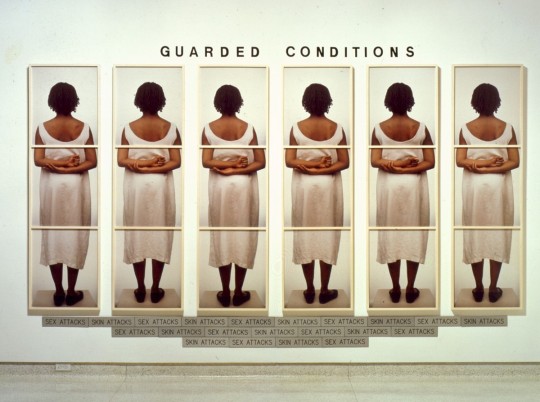
Lorna Simpson, Guarded Conditions (1989)
https://www.artspace.com/magazine/art_101/book_report/representing-the-black-body-lorna-simpson-in-conversation-with-thelma-golden-54624
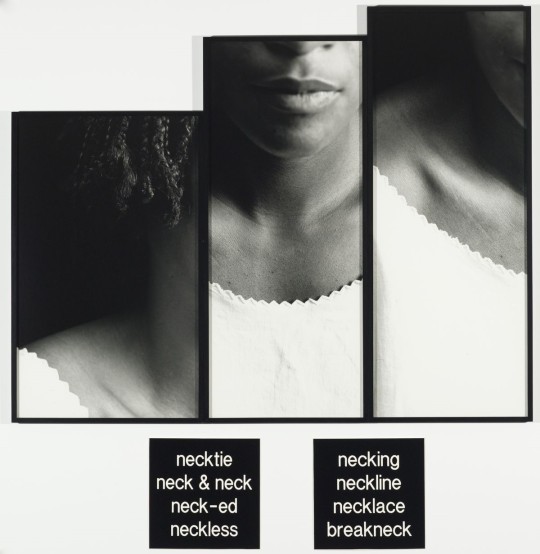
Lorna Simpson, Necklines (1989)
https://mcachicago.org/Collection/Items/1989/Lorna-Simpson-Necklines-1989

Lorna Simpson Wigs (1994)
https://www.moma.org/learn/moma_learning/lorna-simpson-wigs-1994/
Childhood
Born in Brooklyn in 1960, Lorna Simpson was an only child to a Jamaican-Cuban father and an African American mother. Her parents were left-leaning intellectuals who immersed their daughter in group gatherings and cultural events from a young age. She attributed their influence as the sole reason she became an artist, writing, "From a young age, I was immersed in the arts. I had parents who loved living in New York and loved going to museums, and attending plays, dance performances, concerts... my artistic interests have everything to do with the fact that they took me everywhere ...."
Aspects of day-to-day life lit up Simpson's young imagination, from the jazz music of John Coltrane and Miles Davis, to magazine advertisements and overheard, hushed stories shared between adults; all of which would come to shape her future art. The artist took dance classes as a child and when she was around 11 years old, she took part in a theatrical performance at the Lincoln Center for which she donned a gold bodysuit and matching shoes. Though she remembered being incredibly self-conscious, it was a valuable learning experience, one that helped her realize she was better suited as an observer than a performer. This early coming-of-age experience was later documented in the artwork Momentum, (2010).
Simpson's creative training began as a teenager with a series of short art courses at the Art Institute of Chicago, where her grandmother lived. This was followed by attendance at New York's High School of Art and Design, which, she recalls "...introduced me to photography and graphic design."
Early Training and Work
After graduating from high school Simpson earned a place at New York's School of Visual Arts. She had initially hoped to train as a painter, but it soon became clear that her skills lay elsewhere, as she explained in an interview, "everybody (else) was so much better (at painting). I felt like, Oh God, I'm just slaving away at this." By contrast, she discovered a raw immediacy in photography, which "opened up a dialogue with the world."
When she was still a student Simpson took an internship with the Studio Museum in Harlem, which further expanded her way of thinking about the role of art in society. It was here that she first saw the work of Charles Abramson and Adrian Piper, as well as meeting the leading Conceptual artist David Hammons. Each of these artists explored their mixed racial heritage through art, encouraging Simpson to follow a similar path. Yet she is quick to point out how these artists were in a minority at the time, remembering, "When I was a student, the work of artists from varying cultural contexts was not as broad as it is now."
During her student years Simpson travelled throughout Europe and North Africa with her camera, making a series of photographs of street life inspired by the candid languages of Henri Cartier-Bresson and Roy DeCarava. But by graduation, Simpson felt she had already exhausted the documentary style. Taking a break from photography, she moved toward graphic design, producing for a travel company. Yet she remained connected to the underground art scene, mingling with likeminded spirits and fellow African Americans who felt the same rising frustrations as racism, poverty, and unemployment ran deep into the core of their communities.
At an event in New York Simpson met Carrie-Mae Weems, who was a fellow African American student at the University of California. Weems persuaded Simpson to make the move to California with her. "It was a rainy, icy New York evening," remembers Simpson, "and that sounded really good to me." After enrolling at the University of California's MFA program, Simpson found she was increasingly drawn towards a conceptual language, explaining how, "When I was in grad school, at University of California, San Diego, I focused more on performance and conceptually based art." Her earliest existing photographs of the time were made from models staged in a studio under which she put panels or excerpts of text lifted from newspapers or magazines, echoing the graphic approaches of Jenny Holzer and Martha Rosler. The words usually related to the inequalities surrounding the lives of Black Americans, particularly women. Including text immediately added a greater level of complexity to the images, while tying them to painfully difficult current events with a deftly subtle hand.
Mature Period
Simpson's tutors in California weren't convinced by her radical new slant on photography, but after moving back to New York in 1985, she found both a willing audience and a kinship with other artists who were gaining the confidence to speak out about wider cultural diversities and issues of marginalization. Simpson says, "If you are not Native American and your people haven't been here for centuries before the settlement of America, then those experiences have to be regarded as valuable, and we have to acknowledge each other."
Simpson had hit her stride by the late 1980s. Her distinctive, uncompromising ability to address racial inequalities through combinations of image and text had gained momentum and earned her a national following across the United States. She began using both her own photography and found, segregation-era images alongside passages of text that gave fair representation to her subjects. One of her most celebrated works was The Water Bearer, (1986), combining documentation of a young woman pouring water with the inscription: "She saw him disappear by the river. They asked her to tell what happened, only to discount her memory." Simpson deliberately challenged preconceived ideas about first appearances with the inclusion of texts like this one. The concept of personal memory is also one which has become a recurring theme in Simpson's practice, particularly in relation to so many who have struggled to be heard and understood. She observes, "... what one wants to voice in terms of memory doesn't always get acknowledged."
In the 1990s Simpson was one of the first African American women to be included in the Venice Biennale. It was a career-defining decade for Simpson as her status grew to new heights, including a solo exhibition at New York's Museum of Modern Art in 1990 and a series of international residencies and displays. She met and married the artist James Casebere not long after, and their daughter Zora was born in the same decade. In 1994 Simpson began working with her grandmother's old copies of 1950s magazines including Ebony and Jet, aimed at the African American community. Cutting apart these relics from another era allowed Simpson to revise and reinvent the prescribed ideals being pushed onto Black women of the time, as seen in the lithograph series Wigs (1994). The use of tableaus and repetition also became a defining feature of her work, alongside cropped body parts to emphasize the historical objectification of Black bodies.
Current Work
In more recent years Simpson has embraced a much wider pool of materials including film and performance. Her large-scale video installations such as Cloudscape (2004) and Momentum (2011) have taken on an ethereal quality, addressing themes around memory and representation with oblique yet haunting references to the past through music, staging, and lighting.
Between 2011 and 2017 Simpson reworked her Ebony and Jet collages of the 1990s by adding swirls of candy-hued, watercolour hair as a further form of liberation. She has also re-embraced painting through wild, inhospitable landscapes sometimes combined with figurative elements. The images hearken to the continual chilling racial divisions in American culture. As she explains, "American politics have, in my opinion, reverted back to a caste that none of us want to return to..."
Today, Simpson remains in her hometown of Brooklyn, New York, where in March 2020, she began a series of collages following the rise of the Covid-19 crisis. The works express a more intimate response to wider political concerns. She explains, "I'm just using my collages as a way of letting my subconscious do its thing - basically giving my imagination a quiet and peaceful space in which to flourish. Some of the pieces are really an expression of longing, like Walk with Me, (2020) which reflects that incredibly powerful desire to be with friends right now."
Despite her status as a towering figure of American art, Simpson still feels surprised by the level of her own success, particularly when she compares her work to those of her contemporaries. "I feel there are so many people - other artists who were around when I was in my twenties - who I really loved and appreciated, and who deserve the same attention and opportunity, like Howardena Pindell or Adrian Piper."
The Legacy of Lorna Simpson
Simpson's interrogation of race and gender issues with a minimal, sophisticated interplay between art and language has made her a much respected and influential figure within the realms of visual culture. American artist Glenn Ligon is a contemporary of Simpson's whose work similarly utilizes a visual relationship with text, which he calls 'intertextuality,' exploring how stencilled letters spelling out literary fragments, jokes or quotations relating to African-American culture can lead us to re-evaluate pre-conceived ideas from the past. Ligon was one of the founders of the term "Post-Blackness," formed with curator and writer Thelma Golden in the late 1990s, referring to a post-civil rights generation of African-American artists who wanted their art to not just be defined in terms of race alone. In the term Post-Black, they hoped to find "the liberating value in tossing off the immense burden of race-wide representation, the idea that everything they do must speak to or for or about the entire race."
The re-contextualization of historical inaccuracies in both Simpson and Ligon's practice is further echoed in the fearless, cut-out silhouettes of American artist Kara Walker, who walks headlong into some of the most challenging territory from American history. Arranging figures into theatrical narrative displays, she retells horrific stories from the colonial era with grossly exaggerated caricatures that force viewers into deeply uncomfortable territory.
In contrast, contemporary American artist Ellen Gallagher has tapped into the appropriation and repetition of Simpson's visual art, particularly her collages taken from African American magazine culture. Gallagher similarly lifts original source matter from vintage magazines including Ebony, Our World and Sepia, cutting apart and transforming found imagery with a range of unusual materials including plasticine and gold-leaf. Covering or masking areas of her figures' faces and hairstyles highlights the complexities of race in today's culture, which Gallagher deliberately teases out with materials relating to "mutability and shifting," emphasising the rich diversity of today's multicultural societies around the world.
3 notes
·
View notes
Text
896
Would you ever try Fear Factor for one million dollars? Why or why not?
Yes. It would make for hilarious stories for get-togethers and I think that winning a million dollars that I could use up for the rest of my life doing some dumb dares for a few hours would be worth it.
If you have a camera, when do you use flash?
Only if it’s dim. I don’t like the effect that flash gives.
What would you do with eighty-three crazy straws?
Find an aunt or uncle with a kid who’s having a birthday party soon so they can use the straws as giveaways or something.
If you use hair spray, what brand do you use the most?
I don’t.
Is Catcher in the Rye in your library by any chance?
It’s probably in another college’s library, most likely our college for the arts and letters. There’s no reason for it to be in a mass communication library.
What if there was no such thing as the word 'one'?
Then that would imply that we have/have to have plurals of everything, which just sounds a bit bizarre to me.
What do you have automatic sympathy for?
The 11,000 employees of the country’s biggest broadcasting network that was recently officially shut down by our – surprise surprise – government. These are people who weren’t even involved in the network’s franchise renewal status (which was/is the main issue), people who have families, people who relied on these jobs to get by during a worldwide pandemic, people who loved their jobs, people who found family in these jobs, It’s absolutely crazy how people can defend their stance against the network and justify the loss of 11,000 jobs.
What is a cool disposable object?
I don’t know who looks at disposable objects and thinks they’re ‘cool,’ but the first thing I thought of was my vape pen of choice, which are disposable. It has enough puffs to last several months with me so it’s more convenient for me to keep buying them than spending a large amount on a refillable one.
Hilary Duff or Lindsay Lohan? Why?
Hilary Duff as Lizzie McGuire is more nostalgic to me; I used to watch it nearly everyday. I never watched Lindsay’s movies other than Herbie.
What do you think of the actor Michael Cera?
No opinion but I remember the time when he was often used on 9Gag memes. Simpler times lol. Anyway, I haven’t seen any of his movies.
What is the best thing about a Barbie doll?
I think it’s really fun how they’ve come up with a bazillion outfits for Barbies and Kens. And different versions too – as far as I know there’s been a Filipino Barbie for a while :)
What is something you'd say in your will?
If I passed any time soon I’d like to include some things about my dogs and how they’re supposed to be taken care of. If we’re talking about what I’m putting in my will if I ever reach like 80, I just wanna make sure every person who’s been in my life and stayed for a bit is mentioned and thanked and I wanna make the list as expansive as I possibly can at that age. Idk, I’ve always been sentimental.
Any thoughts on fake abortion clinics?
What??? I don’t know what those are and what they do, but they sound awful.
What was a username you'd thought wouldn't be taken but was taken?
I’ve tried using my full name as a username in a few websites and seen them being taken. My first and last names don’t make a common pair, so I’ve always found it surprising.
Cherry or peanut ice cream?
Peanut. Not gonna lie, it’s an unusual flavor – but Asians kinda put peanuts on everything heh.
What is your dream cellphone? Why?
Whatever new phone Apple puts out because unfortunately I buy into toxic consumerist shit like that lol
Would you rather be watching The Bachelor or The Bachelorette?
Neither.
From one to ten, how big of a movie buff are you?
I’d give myself an 8. I’ve seen my fair share of movies and I can honestly say that my favorite films are not cliche picks, but I’ve also yet to see a bunch of classics that other ~movie buffs~ hail as being excellent movies like Taxi Driver, Silence of the Lambs, Rocky, American Psycho, etc. I also haven’t been watching movies as much as I used to, which takes down another point for me.
Who is a celebrity you think will never get into trouble?
The Irwin kids. I wouldn’t call them celebrities per se though; they’re in the spotlight for the most wholesome reasons. I’ve seen every segment Robert Irwin has had on Jimmy Fallon and it’s amazingly precious.
What is an important holiday to you? Why?
Probably the EDSA Anniversary because without it we’d still be under a dictatorship.
Name a catty girl you really dislike.
I wouldn’t call anyone I know that.
What is a museum you would like to go to?
The top 3 museums that I would love to visit are the Anne Frank House, the Met, and the Art Institute of Chicago. And wherever Monet’s paintings are, because he’s my favorite artist.
Personally, do you look better with short hair or long hair?
Short. Long, frizzy hair does not look good on me and on anyone else.
What was the reason why you last blocked a person from your IM?
He was a stranger who hit on me. I added him back only because we had a considerable amount of mutual friends and I thought that maybe he used to be a classmate or something, but he messaged me some shit that he had probably copy-pasted to 700 other girls saying like ‘hey do you mind if you and I talk? I find you really pretty’ like six seconds after adding him back. It was so fucking creepy and I never blocked someone so quickly. I was already in a foul mood that night so I also showed the brief interaction to Gab and I gave her freedom to curse the shit out of the guy if she wanted to.
What is a cliche thing that happens a lot in anime?
I don’t like anime and have never watched it.
What are your views on the cartoon show Invader Zim?
I’ve never seen that either.
If you have some, what is tonight's homework about?
I don’t have homework anymore.
If you have one, what is your favorite sushi flavour?
Cream cheese salmon rolls from a local place called Torch.
What is the first thing you think of when I say 'Jack'?
Rose.
Do you understand JavaScript coding?
A teeny bit, thanks to the theme customizations I used to do on Tumblr when I was 14.
What would you do if you found a gun in your best friend's bedroom?
Confront them, and maybe even scold them. I definitely would be angry. Not even just because it could mean they’re suicidal, but because I don’t believe in guns.
What do you call your grandparents?
I call both sets Lolo and Lola.
When I say 'Go', you say:
I just remember the song Green Light by Beyoncé because the chorus on that is her screaming ‘Go.’
What colour do you usually paint your nails?
I never paint them. They’re pretty, but I never saw them as a necessity.
What would be a cool earring design?
People come up with cool designs all the time now though. I’m completely sure there are a million versions of this now but I would love sriracha sauce earrings haha.
What do you think of raccoons?
No opinion as I’ve never encountered them.
Any thoughts on the actor Paul Rudd?
NEVER AGES
Who is the better liar: your mother or your best friend?
Mom. Gab will lie to me sometimes but I can always tell.
Are breast implants something you'd consider? Why or why not?
I considered it when I was a teenager because people used to pick on me for being flat-chested, as if I had a choice as to what size my body would end up being. Also, flat chests were the butt of so many jokes in the early 2010s so it made me insecure for a very long time. Nowadays the environment is a lot nicer and I’m seeing many flat-chest positivity posts (if that’s even a thing) so I’ve changed my mind about implants.
Besides nightmares, what is the scariest thing about sleeping?
Sleep paralysis. You can wake up from nightmares.
Do you find the phrase 'nom nom nom' annoying?
Not as much as ‘rawr’ annoys me.
Do you look better with red lipstick or black lipstick?
I look good in neither but I would go with red.
When was the last time you had chocolate milk?
Oooooh it’s been a while :( I feel like that’s something people have to start selling more, honestly. I don’t see chocolate milk being sold other than at the grocery or convenience stores and ugh, I just want more restaurants to add it on their menus lol. That being said, the last time I had it was in January, during a journalism workshop that we hosted in a school in Marikina. The teachers offered us that and a Fudgee Bar as thank-you snacks :)
1 note
·
View note
Text
The Exam
Best Music Moment of 2019
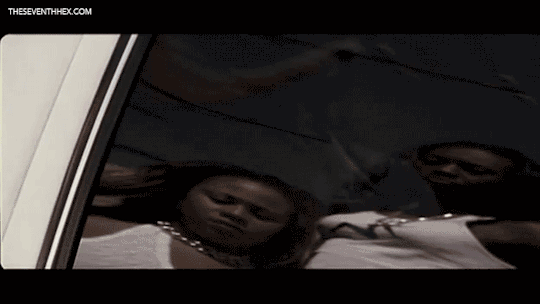
BC: Three straight hours of this
youtube
in my Chapman Ryder Cup match with Code
-The Robert M. Chennault Playlist in my Ryder Cup match with Laser
-Vampire Weekend's "M79" with Parks and Rec theme interlude in Pawnee Peytonville with my babe
-Late night music game with JD and Chaps this Fall
-My kids competing for best air guitar solo to Daft Punk's "Digital Love"
-The Stones soundtracking Raceday morning with Counterfeit Kenny and the Kennel Boys
Codem: -Picking up the keys after closing on #our house and listening to Arden's dreams for the pad while listening to the songs that brought us together in the first place.
-Perched in the balcony of Park West watching Chromatics live and in person.
-The Chapman format playlist that Brendon and I put together. It was just one song on repeat. Xtal - Aphex Twin
-Plugging in my klipsch's for the first time in the new house to listen to elliott smith on the day of his death. the sound of his discography wafting throughout the whole house was a true delight.
Bronco: My 6-year-old discovering Green Day. My 9-year-old discovering Metallica. Both discoveries have awakened something in them that is hilarious and awesome to behold. And seeing Tool was pretty flaming awesome.
JD: March: Realizing I’d never heard this Stones song, nodding along to the opening riff, and exploding into my biggest laugh of the year at the first line.
youtube
June: The Joni Mitchell performance in the Rolling Thunder Review documentary on Netflix.
June: Catching the Thom Yorke Anima short film at the IMAX theater on the Upper West Side.
July: Code and I getting a perfect 99 score on the greatest rendition of “Emotional Rescue” karaoke you’ll ever see.
October: Playing the music game WAY too deep into the night with BC and Chap (look for the next day’s hangover on my worst moments list).
Chap: Patrick Stickles singing "I'm sorry dad no I'm not making this up" to his dad in the audience.
Nasty: Listening to music at BOB. Nothing but jams that whole weekend. Driving in with Laser - GOOGLE MUSIC JAMS. Trip to the casino - JAMS. Hanging out on the deck - JAMS. Driving to the course with Blazer Black - Fuck Buttons - Sweet Love for Planet Earth aka JAMS. In the cart with Code - JAMS. Driving Chappy and Sfreddo to the rental car - JAMS (but quietly).
Larse: Greta Thunberg speech dubbed to metal
youtube
Best Shows Seent in 2019
Nasty: The Killers @ Summerfest. Hot Fuss will always be an all-time favorite album and Mr. Brightside is the best pop song of our lifetime, IMO. Also, my wife loves them which is about the only band in middle of the venn diagram.
Larse: The Lonely Island at Summerfest
BC: Dead & Company
JD: 1. The Rapture at Music Hall of Williamsburg
2. Viagra Boys at Bowery Ballroom
3. The Strokes and Parkay Boys at the All Points East fest in London with drunk lads screaming along to the guitar parts
4. B Boys at Union Pool
5. Titus Andronicus at Bowery Ballroom
6. Avey Tare at Market Hotel
7. Tame Impala at MSG
8. Weeping Icon at Elsewhere
9. Priests at Elsewhere
Code: interpol - chicago theater
illuminati hotties - hideout
it looks sad - subT downstairs
robyn - riviera
steve malkmus - art institute
eleventh dream day - hideout
colleen green - sleeping village
swearin' - lincoln hall
surf curse - subT
shura - the bottle
Chap: TA was the only show I saw. It was great!
Bronco: All of them. They were each great in their own way. Aside from Tool I was able to interact with the band members at each of the shows. One I didn't have a ticket for and scored one at the door. One was in the tiniest venue I've seen a show at. One had a surprisingly entertaining opening act. And Tool surprised me with how much I enjoyed an arena show despite being so far away I couldn't see the facial features of the band members. And there was SOOOOOOO much weed being smoked in the Garden that night. And I was with a few good buddies. And I was able to sell my fourth ticket for twice what I paid, simulatenously covering me and my fourth friend who had to bail because his life sucks because his wife sucks.
Confession of 2019

Nasty: I consume more music at my cushy, suburban OrangeTheory workout classes than in my own free time. S/O to Coach Vanessa for having some Girl Talk on her playlists.
Codem: i had more fun listening to stuff that i already knew about than stuff that was coming out.
BC: I saw a Yacht Rock cover band and didn't hate it
-I succumbed to social pressure and saw DMB
-I didn't realize until the last minute that my favorite album was released in 2018 (Wild Nothing). Removing it greatly reduced my loyalty to my list.
Bronco: I'm losing my edge. I enjoyed way more lady singer bands this year than in any other year.
Chap: Couldn't get my shit together on the tracks list so just posted a random playlist
Larse: Not really a confession but more of a TIL (today I learned), but Raphael Saadiq was an original member of Tony! Toni! Tone!
Biggest Disappointment of 2019
Bin: The National @ Summerfest. From the Milwaukee Journal Sentinel "the frontman was completely detached, even confessing at one point that he was excited to get back home to his family. The result was an incredibly depressing show — which, given the band's dour songs, is really saying something." ... Huge Bummer.
BC: Didn't see nearly enough shows with nearly enough of yous
Chap: Sturgill Simpson... unlistenable!
Bronco: Baroness.
Laser: Modest Mouse opening for The Black Keys
Code: i was really messed up by dave berman's passing. i had tickets to see him play at the end of august. it was going to be my first catching him live and in concert. i had waited for this moment since i picked up american water back in 2003. two weeks before he was supposed to come through town, he up and died. also, much less of a bummer, the chromatics show in miami that Arden and i were going to attend got canceled two days before the show.
Most Overrated of 2019
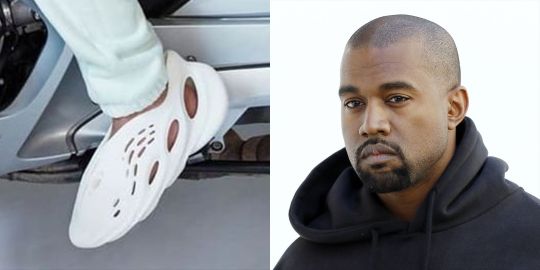
Nasty: Kanye's shoes
Chap: LEGACY! LEGACY! – Jamila Woods seems to have been highly regarded? Not my thing
BC: FKA Twigs
Bronco: Baroness.
JD: Big Thief
Code: cancel culture
Larse: Mayor Pete
Make it Stop 2019
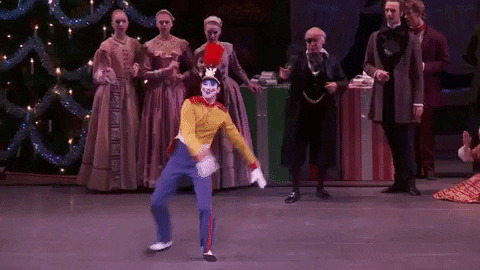
Chap: In my house, the Nutcracker Suite. It's great, until the 300th time that day.
Nasty: Cage the Elephant (but children, instead of elephant, and in real life, not the band)
BC: Lizzo
Code: lizzo
JD: Memes
Larse: Trump
Bronco: News
Biggest TBH Regret of 2019

Chap: Can't seem to get to more than one show per year; Jessica Pratt in a church by my old place
JD: Missin’ dat Pratt yet Nick!
BC: Should've listened to the Kanye album. Should've spent more time with the Deerhunter record.
Rotty: Skipping CHVRCHES at Summerfest
Code: another year with no fog party
Nasty: Not going to Indy 500. lol jk.
Bronco: I didn't buy tickets to a few shows I would've liked to have seen. One of them I went to the venue and didn't get in. That bummed me out, but I crossed the street and had a few beers by myself for good measure, so it wasn't a total loss.
Detective Murtaugh of 2019
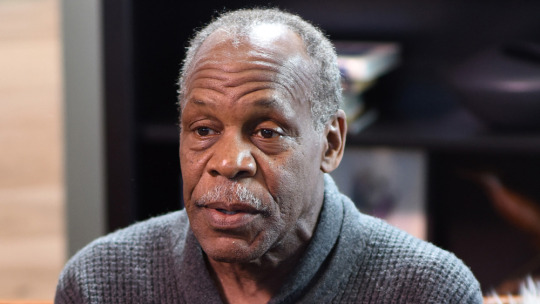
JD: Everything.
Bronco: Shows that don't start until 10pm. That Girl Band show nearly wrecked me.
Chap: How much I loved Bruce Springsteen's adult contemporary western-themed old-man album.
BC: The ten seconds I lasted with 1000 GECS
Nasty: For the life of me - I cannot figure out how to operate the "play next" queue on these apps.
Laser: Lizzo at Summerfest - lot of younglings running around; people were racist towards Lizzo's security guards, she vowed not to come back to MKE, one of the most segregated cities in America :(
Resolution for 2019 Status
Laser: —
How It Went: Who can even remember this shit...I'm sure it was that I'd do better at keeping track or listen to more shit people suggest and I'm sure I failed.
BC: Listen to one new album a week; reboot the Classic Album Review Club
How It Went: Noooot toooo gooooood
Code: catch ovlov, pictureplane, washer, chromatics, EMA and colleen green live this year.
How It Went: i saw chromatics and colleen green. last i checked .400 gets you into cooperstown.
JD: Greater consciousness of how I’m using my attention - an ineffectual and meaningless protest of the ways the world is burning down in pursuit of it.
How It Went: Not bad! I especially nailed the “ineffectual and meaningless” part.
Chap: Learn Piano; Guilt Joe Dons into finally inviting me to a concert.
How It Went: Learned some piano but got to busy for it... Couldn't guilt JD to invite me anywhere but I DID invite him to a show! The same one I went to! With him!
Bronco: Read more 'classic’ books. I didn’t read many of them, even in school (especially in school? Never could read a book I was told to read). But I’m leaning in the sci-fi direction of 'classics’. I just read Dune this summer, and wrapped up Fahrenheit 451 the other day. I’m feeling an unexplained need to beef up my nerd credentials and this seems the way to accomplish it.
How It Went: Nope. Fell back in to zombie-apocalypse genre series that I've been reading for a while. But I am currently reading arch-nerd Neal Stephenson's "Fall; or, Dodge in Hell". It's almost 900 pages, I feel like I've been reading for months now, and because I'm a stupidly slow reader, I read only before going to bed, and can only make it 10 minutes before falling asleep and hitting myself in the face with my phone, I'm only 25% of the way through. But man is it painting a creepy yet eerily plausible scene of the near future. Guy just knows how to write.
Nasty: Hope last year I was smart enough to leave this blank. (editor’s note: [removes shoes, pets cat, puts on slippers, retires to favorite easy chair, sips martini, slowly pulls reading glasses out of cardigan pocket, dusts them off, loads todaysbiggesthits.tumblr.com, scrolls to ‘Resolution for 2019’] “Nasty: I’m sticking with it - get to NY for a show with JD.”)
Resolution for 2020

BC: See Phish in 2020
Codem: i'm making it easier this year. catch ovlov, washer, EMA and colleen green live this year. bonus points: see dom's much anticipated return to the stage.
Bronco: Build a vinyl collection. I know I dumped on Brendon for suggesting he press copies of Carpet Affair, but my kid's getting way into music and listening to it on his own (via Alexa in my bedroom which is super fucking annoying), so we're getting him his own record player and I think it's going to be a cool activity to go record store diving for whatever classics we can scrounge up.
JD: Get to more shows. Take more aimless strolls spinning tunes.
Bin: Send an email about music on the TBH! thread.
Larse: None
Chap: Eh I'm cool
Most Anticipated of 2020

Code: my man dom said that he is coming back to the world this year. i have to believe that he'll keep his word. i'm thinking 2020 is going to be the year for chromatics' Tommy.
Chap: TWOD, Perfume Genius, Jason Isbell
BC: Huey Lewis and the News, Tame Impala, Run the Jewels
Bronco: Kvelertak and Mastodon, maybe some surprise extra Tool material?
JD: Working Men’s Club
Nasty: Spotify getting Jay-Z's catalog back.
1 note
·
View note
Text
5/9-15: Went Chicagoan Jewish for a Day (or not really) (aka ‘antek-antek Yahudi!’ as some jerk would say)
33rd WEEK, MAY 9-15, 2016.
Many exciting things happened this week.
But I have the right to prioritize which one deserves to be mentioned first.
This Thursday, I finally (finally) watched Captain America: Civil War.
And if you’re reading this blog for quite some time, it can be seen that I am sort of a hardcore MCU fangirl. At least compared to my friends.
I just died watching the movie. Imagine my heart is an egg and the movie screenwriters and actors were some extremely good scrambled egg makers.
I just can’t.

I cussed and swore so much during the movie, even though I was there by myself (actually—it’s because I was there by myself), and just being emotional in my own little world. By the time the movie was over entirely, I didn’t even have the mood for anything. I was either about to explode or just melt and let myself washed away to the drain and to the Puget Sound. And never come back again.
Huh. I wish my fangirl fellow Darin or Ica was here. They have been the only ones qualified enough to talk the shit out of any marvel movies with me. We can handle each other, and other people, apparently, just can’t handle or understand me being emotionally overwhelmed over some fictional stuff.
Anyway.
Summer is approaching, and on Wednesday the 11th the day hit the thermostat a good 26 Celcius, so after school I went to Capitol Hill and bought myself an unapologetic cup of frozen yogurt across the street from Seattle Central.

However, the highlight of the week, like with almost all cases, came on the weekend.
Karen’s nephew, Gabe, was having his bar mitzvah that weekend. Good news: his family, of course, invited Karen and her family over for it. Good news #2: Karen’s sister and her family lived in Chicago, IL.
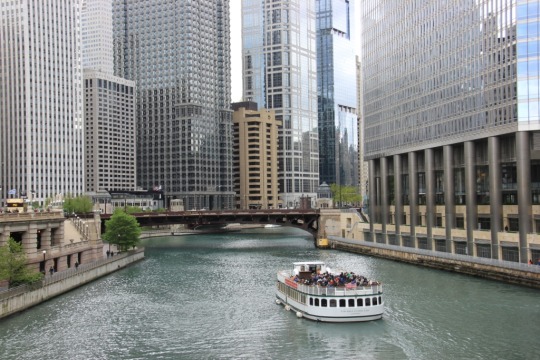
Hell yeah! It’s not everyday you can go to big cities like Chicago (unless, well, you live in or nearby Chicago) AND go to a bar mitzvah (unless, well, you happen to have a lot of Jewish relative or friends).
For those who haven’t known, bar mitzvah (or bat mitzvah, for female) is a coming-of-age ritual, meaning a ritual that marks a young person’s transition from being a child to being an adult, that is practised by the Jews—
“Jews?!”
—is probably what your response would be if you’re a typical, religiously conservative Indonesian Muslim who credit most of your knowledge to controversial-titled articles on Facebook that are shared by friends from exclusively your own circle.
But I’m getting ahead of myself, and I’m not supposed to talk about my tolerant/intolerant country in this entry, so let’s get back to my main point.
Gabe here was 13 years old, so, in order to mark his coming to adulthood, a bar mitzvah was held. Let’s say... uhm, a bar mitzvah is an equivalent to Indonesian ‘khitanan’, a ritual after a boy’s circumcision to celebrate his first steps to adulthood.
Karen and Eric and I left Seattle in the afternoon, which means I had to leave school a couple hours earlier to catch the plane. After we arrived, we rented a car and drove to the hotel. Later at night, I finally met Ayesha, Karen’s mother, and us four spent some time talking.
Saturday morning, we went to Downtown Chicago to have breakfast and walk around. We crossed the Chicago River and passed by the Trump Tower. But our main destination was Millenium Park.
You see, when I thought of Chicago, I thought about this particular piece of art I wanted to see for myself. It was this sculpture, sitting right in the middle of the park. The sculpture has a power to amaze everyone who sees it, and at the same time providing a new perspective to see the Chicago skyline and the buildings surrounding it. Designed by an Indian-British artist Anish Kapoor in 2004, the stainless-steel sculpture was initially and officially named “Cloud Gate”. Thanks to public’s creativity and appreciation of its shape, the sculpture is more widely known as... The Bean.
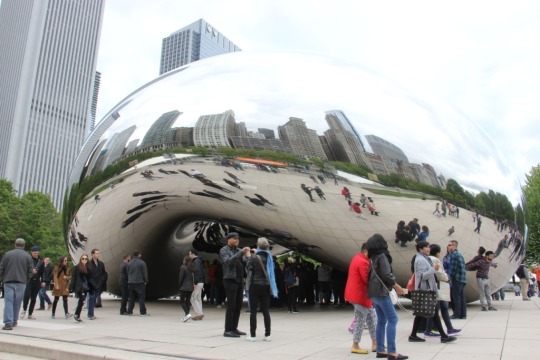
To be fair, it DOES look like a bean. However, I felt somewhat sorry for the artist that had surely thought about the philosophy behind the name Cloud Gate and how the name will inspire people and all that. But I guess the first time people saw the sculpture, they went “oh, it looks like a giant bean!” hence the name.
Think about nicknames that you give to your friends or that have been given to you by your friends. It’s like how a person is named Richard, but everyone just end up calling him Dick. Or a name as pretty as Zahra but everyone end up calling her Ijah. Or something like that. There are indeed some people in my school who are so widely known by their nicknames, anyone hardly know what their real, birth names are.
However, in any way, The Bean (or Cloud Gate, whatever) is so pretty, no matter the weather. It can be sunny or cloudy and it still manages to reflect the whole scenery around it perfectly.
And right under the bean structure was ever crazier. The structure was bent and shaped in such a way that it provided multiple reflections of you in different forms, like a kaleidoscope. Looking at it was hypnotizing, and making me dizzy if I stared at it for too long.
Oh, and it’s cool that I could see the photographer in the picture because he was reflected by the bean behind me. Ehe.
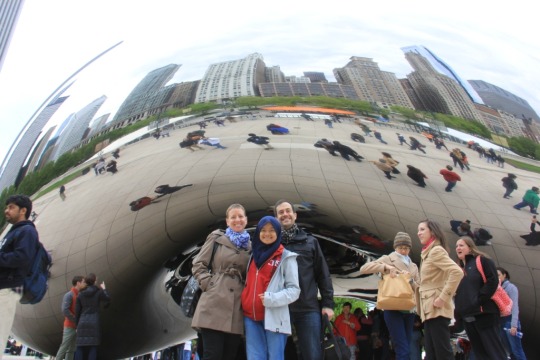
Then we moved to the next block, the next cool thing about the city, the Art Institute of Chicago. (which is what we could cram in a day of Chicago) More than a place where people study—like the sound ‘Institute’ gives—it was more like a museum, like the Met. It had everything in there, for real.

I would say that the Met has more complete collection than Art Institute of Chicago just because the Met is more famous and the whole building is probably as vast as my neighborhood back home, but AIC contained a lot of artefacts and other kinds of old stuff from different times and places, like Ancient Greece and Roman Empire. There were also extensive collections from the Middle East during the rise of Islam, from India, Africa, China, and Europe, with artefacts related to their respective culture and certain religion the region was dominated by.



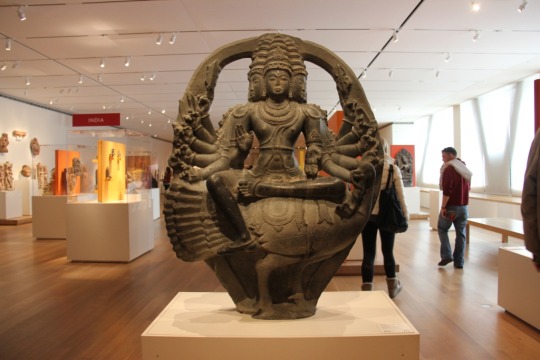
I’m a statue person, and most likely not a painting person. Seriously, though, my art senses are probably dull enough that I don’t enjoy paintings as much as people do in general (especially those of abstract paintings). Thus, what I did when Eric and Karen and pretty much everyone in the room were philosophically and emotionally connected to an acrylic representation of grass, I took pictures of them.
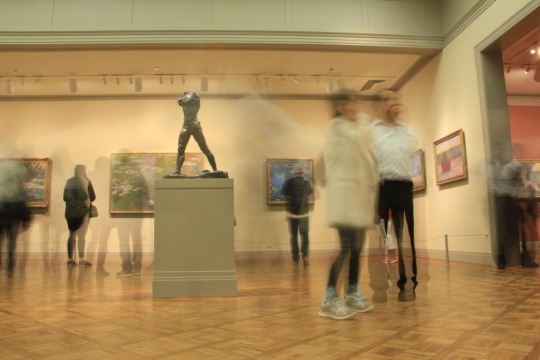
Alright. Time to bail as evening was approaching and we needed to be at Karen’s sister’s house for dinner before the ceremony. Karen told me to dress real formal—because maybe last time they took me to a formal event—that was a wedding—I wore a cardigan over a long-sleeved shirt and—wait for it—a pair of sneakers. Karen made sure I did NOT wear sneakers (or shirts) for the bar mitzvah, and thus, left me with the only acceptable shoes I had: a painful pair of high high heels. It was black and fancy and I looked good in it, but it was for sure after the event I decided to throw those elegant representation of hell.
When we got to the venue, it became clearer that it was indeed a black tie event. Good thing about having a dinner party with the Jews: kosher food! Kosher is like food guidelines for Jews, the same way us Muslims categorize food and beverages into halal or not halal. Now, I don’t know the full scope of what makes a food or beverage kosher, but I do know that both kosher and halal guidelines strictly and entirely prohibit swine (or any kind of pig product), and that is good enough for me in this kind of situation.
Quick tip: when you’re in the US and is really self-conscious about your belief in halal diet, if you can’t find a proven halal food, look for kosher ones. (especially for products in packaging like salt or biscuits and such kinds, finding a kosher mark in the packaging is good enough if you can’t find products with halal mark on it)
After dinner we moved with our respective vehicles to the synagogue for the ceremony. Synagogue is a Jewish house of prayer. Before we entered the main room, the men were given this small head covering—that was so small it didn’t really cover the whole head—that I’d later figured is called a kippah. Gabe, the man of the hour, besides wearing a kippah himself, also wore a kind of prayer shawl called tallit.

(illustration--photography was not allowed during the ceremony--at least the one i attended)
During the ceremony, there were chants and songs—in Hebrew—but the main event was the reading of the Torah—big rolls of Jewish scriptures. Presumably just about everyone in the room paid attention to the reading but me, but to be honest it’s not even easy for me to concentrate when an imaam—the leader of a Muslim prayer, when done collectively—recites long verses of the Quran during prayers (being able to read and write Arabic doesn’t help when you can’t understand the language itself), let alone a set of long verses in Hebrew. So what does a girl with zero understanding of the Torah and a quite short attention span do during this time?
She decided to open the holy book in front of her seat and tried to decipher the Hebrew alphabet.
Prepare for a quick elaboration on her observation regarding Hebrew and its comparison to Arabic. (<--calon judul skripsi S1 Sastra Arab/Ibrani)
I guess now I understood why people who don’t understand Arabic see nothing but unreadable wiggly lines—even I’ve heard people said to me that all the scribbles look the same. It took a while for me to figure out that Hebrew and Arabic have pretty much the same system. (uhhh I don’t know how to explain this. But like in Arabic a letter needs to have an accent that serves as a vowel, in order for the letter to be readable. So, for instance, if there is a certain accent above the Arabic letter ‘s’, that accent’ll give an ‘aah’ sound so the letter will be read as ‘saa’. Another accent gives the ‘ooh’ sound, hence ‘soo’, and another gives the ‘eeh’ sound, hence ‘see’) (why am I suddenly giving Arabic lessons)
Anyway, it’s not exactly the same, but some letters in Hebrew, if accompanied by certain accents or additional wiggly line, will be read differently than without accents.
(I can’t give you an example) (because by the time we all got home in Seattle I already forgot the whole thing) (not that you asked for one anyway right)
(well, I guess it would be kind of cool if I preserved on deciphering Hebrew. Albeit the language itself I can’t understand, at least I can write things I don’t want people around me to know in Hebrew letters)

After the whole ceremony ended, we moved to another room, which was a vast hall, where we had dinner (again) and heard speeches and overall celebrated Gabe’s first step into adulthood. Pictures would’ve been cool, but photography weren’t allowed during such ceremony.
The next day, on a nice Chicago Sunday morning, all the family members gathered in a cafe for brunch. Got into some more talking with Karen’s extended family members, since I didn’t do so much talking during dinner the previous day.
It was quite a small place for such a big family and it wasn’t as easy to move around, but I got to one point where I met one of Karen’s family members (I forgot who, sorry) who happened to be the heart surgeon for Indonesia’s back-in-the-day famous General A.H. Nasution. (General Nasution was a member of the military who was lucky to escape the terror attack from rogue members of Indonesian Communist Party in 1965) (it took a while for me to figure out when he was telling me he did a surgery for Nasution, because apparently if you pronounced the name ‘Nasution’ the English way it sounds waaaaaay different than the Indonesian way)
As if it weren’t enough, I met Karen’s brother-in-law and he told me he’d met Indonesian former president Susilo Bambang Yudhoyono. Give me a break. I technically live closer to President SBY and I’ve never seen the guy live, or even General Nasution.
(well, probably NOT General Nasution, as the guy had died long ago)
We went back to the hotel and took off to the airport right after, Karen’s mom Ayesha came with us to the airport so she could tell me about my personality and prospect for the future through my birth date and place and chakra flow. Accompanied by good thick Chicago pizza. Mmm.

It wasn’t exactly a trip to Chicago a tacky tourist like me would expect because we barely got around Chicago, because it really isn’t a tacky tourist kind of trip, but a family event. Nonetheless, if I think wide and positive enough, chances of me visiting Chicago as a tacky tourist is bigger than chances of me attending a bar mitzvah. Therefore, one shall not remorse on being unable to explore Chicago, because one can always come back.
(aamiin)
(brb melamar jadi buruh cuci tetangga)
And I shit you not, the experience of attending a bar mitzvah is one of the most impressive point in my exchange year I will always remember. Thinking about the time where I could casually walk into a synagogue without being questioned (maybe Karen gave a heads-up to the family, I assume?), and imagining how a Jew—or anyone else, for that matter—should always be treated the same way if the situation were to be reversed.
Peace out.
Salam dari yang baru pakai high heels dua kali langsung dibuang,

Nabila Safitri.
1 note
·
View note
Text
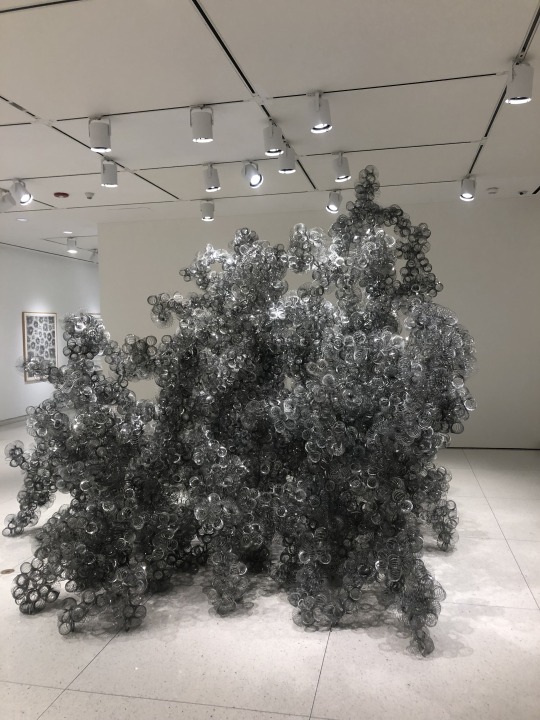


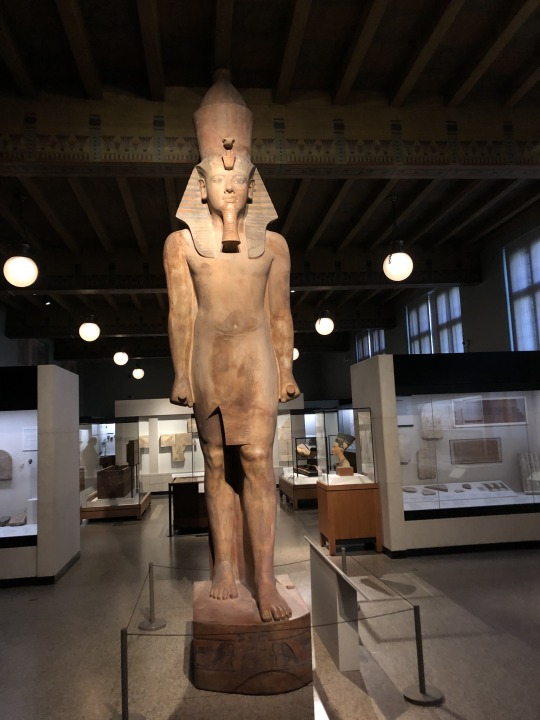
Blog #7: Choose Your Own Adventure
Today we were given the opportunity to take a trip on our own or with someone of our choice. I decided to ask my friend from high school. I asked him specifically for two reasons; one being we haven’t seen each other in a while because he goes to school in another state, and also because I know he knows nothing about art and probably would never go to an art museum. I thought it would be interesting to take someone with his mindset and pick his brain about different pieces now that I have a better understanding of art. Surprisingly, he seemed interested in the art and took a good amount of time to examine each piece and read any information that came with it.
Our first stop of the day was to the SMART museum. We hopped off the train, hopped in an uber and were on our way. After about a 15-minute ride we arrived to the museum which was right on campus of University of Chicago. At the smart museum the first thing I noticed was the drastic size difference in comparison to the Art Institute or the other institutions we visited earlier in the week. I would say they managed to get their hands on some pretty cool and unique pieces that I really enjoyed. They seemed to have more 3-dimensional art as well as sculptures that took up significant amounts of the room. The thing that stood out most to me was the slinky sculpture that had multiple pieces and took up a whole room. Aside from looking extremely cool it was refreshing to see some sculptures that played some tricks on your eyes and did not require too much history or background information.
The next stop we made was to the Oriental museum, also located on University of Chicago’s campus. This museum appeared to be similar in size to the smart museum but was much more history and artifact based. I enjoyed this because I love learning about history and where we came from and how far everything has come. It was at the oriental museum where I saw something very cool that I seemed to really take interest in and connect to. It was a case full of tools and toys from Mesopotamia. This was the first river valley civilization and was located in the fertile crescent. I found it cool to see what kids would have played with in that time period as well as their silverware and other things. This really put things into perspective regarding how good we have things today. I think I felt this connection simply as a result of being a kid at one point in my life and I found it fun to imagine myself playing with the toys from this time period and using their utilities.
I believe it is safe to say that I had art biases prior to joining this class and towards the end of the class I can appreciate the other types of work, but I still have these biases. My personal preferences have always been either pencil drawings, artifacts, portraits or realism. I find these styles easiest to connect with while I appreciate not having to dig incredibly deep and stretching things to try to find meaning in them, while it might be fun sometimes. An example of an artifact I saw at the oriental museum was these Egyptian carvings on concrete walls and a tall statue. Contrary to my preferences my dislikes have always stayed consistent. I tend to not like most abstract work. I understand its value and place in the art world but have some problems with it. I think that abstract art and sculptures can carry a lot of meaning, however, sometimes it seems like things can be stretched and blown way out of proportion. At some point it needs to be defined what is and isn’t art, otherwise people can call anything art which may be up for debate, but it would make art very hard to value or show.
0 notes
Text
Art Institute of Chicago
I attended the Art Institute last Thursday, the 14th. I entered the museum and went directly into the Photography room. I chose to go here first, not because it was right in front of me, but because I have been so interested and in love with photography since high school. At first, it was overwhelming because it was much busier than I thought it would be for a week day, but after about five minutes or so I became adjusted to the crowd and found it relaxing to wander through the hectic atmosphere.
The first piece I was attracted to was Andy Warhol’s Mao (1972). I was attracted to these photos because of the vibrant colors used. Warhol used the same portrait of Mao Zedong and used different variations of color for the skin, shirt, and background. My first thought was wondering why he used the colors he did, but I found that the use of bright colors were most likely being used to catch the eye of its audience; it definitely worked.

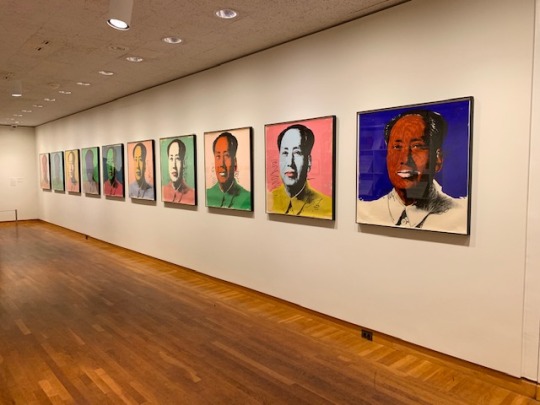
The second piece that caught my attention was located in the second room we entered; Paperweights. I love nature, so not only did the nature aspect of it interest me, but the detailing did as well. If you look closely, you can see the bees in there, as well as the beehive and the flowers. This piece portrays the bees to be flying around the flowers and hive, with some even resting on them. Flowers are one of my favorite parts of nature, so I really enjoyed the color and detail of them. I found this piece to be my favorite in the room because, although the others were beautifully mesmerizing with their fine detail, this weight was the only one that related to nature. This piece was titled Honey Bee Swarm with Flowers and Fruit, 2012, by Paul Stankard. I also thought it was unique that they had a whole room dedicated to paperweights of all different sizes and incredible detail in each.

Finally, the third piece I found was in the Prints and Drawings room. I couldn't quite figure out the meaning of this drawing, but I related it back to our previous Discussion Board on the elements and principles of design. This drawing, Tenth Stone (1968), depicts both the elements and principles of design very clearly. There is the use of different shapes that show the contrast of light and dark shading, along with the pattern continuing around the outside. I was attracted to this drawing because it brought up many questions for me, and left me wondering what it symbolized. It allowed me to have an open mind and really think deeper into it to try and come up with my own conclusion of what it could be and what it meant.

The piece I was least attracted to was the Shino-glazed Flower Vase by Kato Yasukage. Although the piece held an interesting shape, I found it to be very bland and boring. However, it did bring me back to our unit “What is Art?”, and allowed me to view it from the perspective of art not being beautiful but still being art. The vase represents a modern piece of pottery and is coated in a glaze finish. If you look closely at the information card, it states, “The bowl appears to be moving or spinning and mixing the colors on the surface.” I found the shape to be interesting, the colors to be pretty, and well blended, but the piece itself didn’t interest me. There was no true history behind it, and I felt it could have been more unique to the culture rather than be considered a piece of modern pottery.

The second piece that I didn't find very interesting was the Statue of a Ram, restored by Italian sculptor/restorer Francesco Franzoni (Roman Art). Much like the vase above, this statue was very plain. However, I really enjoyed the history behind it. My senior year of high school, I learned a lot about the Greek and Roman Gods and how animals were very significant to them as a means of sacrifice. The statue is a marble piece with fantastic detail of its coat, horns, face, and hooves, but as a whole it wasn't very “eye-catching”. I feel that a piece very similar to this could be seen in more places than just a museum, and because of that I don’t find it to be very unique. I think artwork should have a “one of a kind” feel to it and this just didn’t bring that feeling to me. I definitely enjoyed the history and meaning behind it more than I did the piece itself.
There were many pieces of artwork that brought an emotional reaction to me, but I found this one to bring me one in a different way. The Rock by Peter Blume shows about fourteen people working on a cite that seemed to have been through a major downfall. It shows the destruction of buildings and what looks to have been a boulder at one point. This reminded me of all the devastation the world has seen, from all the wars of past and present, the outcome of 9/11, and even all of the natural disasters. In this oil painting, you can see the people doing extreme manual labor and working hard to rebuild what has been destroyed. This brought a sense of sadness to me as I related this to all of the first responders that dedicate their lives to helping rebuild communities that have been effected by unfortunate events and those who risk their lives to serve our country. I found this piece to be absolutely beautiful and full of detail. I loved the realism of it and how it depicted devastation so greatly to show the true struggle people actually go through afterwards.

Responsive Time Exercise:
The piece I have chosen for my responsive time exercise was Marc Chagall’s The American Windows. This was hands down, one of the most beautiful pieces I saw throughout my time at the museum. I chose this piece because there was so much to look at and process, and felt it was the most appropriate choice for this part of the assignment. As I sat and observed the piece, I first noticed the variety and shades of color used. I loved the different shades of blue being incorporated with brighter colors such as yellow, red, and orange. The longer I sat, the more I noticed the smaller details. What caught my eye first was the person playing an instrument in the top left corner. The yellow color and black outline made it stand out the most. After I analyzed the first panel, I moved on to the next and noticed that there was mostly blue present. However, I loved the wheel of orange, yellow, and green squares bringing “life” to a darker place. The last panel below has lots of different detail. As you can see, there is a person holding a type of mask, the five lit candles, and even some sort of fairy-like image. This piece brought a sense of comfort the most I sat and analyzed it because it was located on a wall with very dim lighting but contained bright colors. I really enjoyed observing this piece because it seems as thought the more you sit and look at it, the more there is to see.


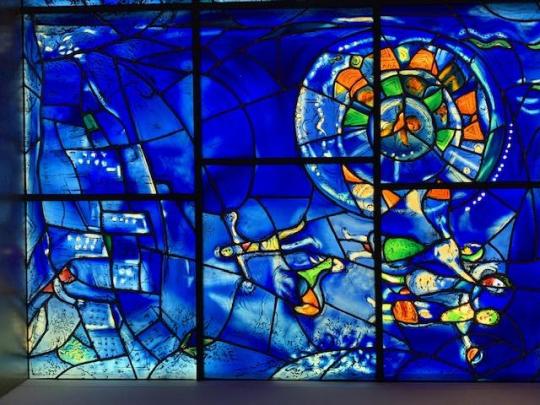

Overall, the Art Institute was a fantastic experience. I feel that it brought me more knowledge on different types of artwork and I learned about the history of many pieces. It made me dig deeper into my thoughts and really get the experience of observing and analyzing artwork firsthand. I loved everything about it and would definitely go back on my own time just to learn more about different cultures and their artwork.
0 notes
Text
Carter G. Woodson
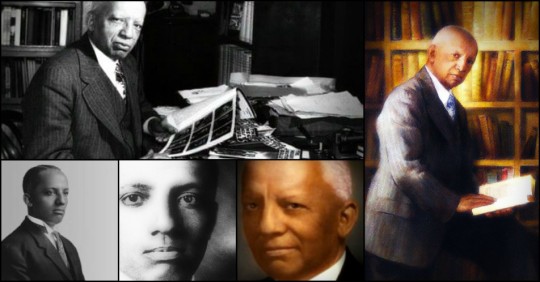





Carter Godwin Woodson (December 19, 1875 – April 3, 1950) was an African-American historian, author, journalist and the founder of the Association for the Study of African American Life and History. Woodson was one of the first scholars to study African-American history. A founder of The Journal of Negro History in 1915, Woodson has been cited as the father of black history. In February 1926 he launched the celebration of "Negro History Week"; it was the precursor of Black History Month.
Background
Carter G. Woodson was born in Buckingham County, Virginia on December 19, 1875, the son of former slaves, James and Eliza Riddle Woodson. His father helped Union soldiers during the Civil War and moved his family to West Virginia when he heard that Huntington was building a high school for blacks.
Coming from a large, poor family, Carter Woodson could not regularly attend school. Through self-instruction, Woodson mastered the fundamentals of common school subjects by age 17. Wanting more education, Carter went to Fayette County to earn a living as a miner in the coal fields. He was able to devote only a few months each year to his schooling.
In 1895, at the age of 20, Woodson entered Douglass High School, where he received his diploma in less than two years. From 1897 to 1900, Woodson taught at Winona in Fayette County. In 1900 he was selected as the principal of Douglass High School. He earned his Bachelor of Literature degree from Berea College in Kentucky in 1903 by taking classes part-time between 1901 and 1903.
Career in education
From 1903 to 1907, Woodson was a school supervisor in the Philippines. Later, he attended the University of Chicago, where he was awarded an A.B. and A.M. in 1908. He was a member of the first black professional fraternity Sigma Pi Phi and a member of Omega Psi Phi. He completed his PhD in history at Harvard University in 1912, where he was the second African American (after W.E.B. Du Bois) to earn a doctorate. His doctoral dissertation, The Disruption of Virginia, was based on research he did at the Library of Congress while teaching high school in Washington, D.C. After earning the doctoral degree, he continued teaching in public schools, later joining the faculty at Howard University as a professor, where he served as Dean of the College of Arts and Sciences.
Convinced that the role of African American history and the history of other cultures was being ignored or misrepresented among scholars, Woodson saw a need for research into the neglected past of African Americans. Along with Alexander L. Jackson, Woodson published The Education of the Negro Prior to 1861 in 1915.
Carter G. Woodson stayed at the Wabash Avenue YMCA during visits to Chicago. Dr. Woodson's experiences at the Y and in the surrounding Bronzeville neighborhood inspired him to create the Association for the Study of Negro Life and History in 1915. The Association for the Study of Negro Life and History (now the Association for the Study of African American Life and History), which ran conferences, published The Journal of Negro History, and "particularly targeted those responsible for the education of black children". Another inspiration was John Wesley Cromwell's 1914 book, The Negro in American History: Men and Women Eminent in the Evolution of the American of African Descent.
Woodson believed that education and increasing social and professional contacts among blacks and whites could reduce racism and he promoted the organized study of African-American history partly for that purpose. Woodson would later promote the first Negro History Week in Washington, D.C., in 1926, forerunner of Black History Month. The Bronzeville neighborhood declined during the late 1960s and 1970s like many other inner city neighborhoods across the country, and the Wabash Avenue YMCA was forced to close during the 1970s, until being restored in 1992 by The Renaissance Collaborative.
He served as Academic Dean of the West Virginia Collegiate Institute, now West Virginia State University, from 1920 to 1922.
In addition to his first book, he wrote A Century of Negro Migration, which continues to be published by the Association for the Study of African American Life and History (ASALH). He studied many aspects of African-American history. For instance, in 1924, he published the first survey of free black slaveowners in the United States in 1930.
He once wrote: “If you can control a man’s thinking, you don’t have to worry about his actions. If you can determine what a man thinks you do not have to worry about what he will do. If you can make a man believe that he is inferior, you don’t have to compel him to seek an inferior status, he will do so without being told and if you can make a man believe that he is justly an outcast, you don’t have to order him to the back door, he will go to the back door on his own and if there is no back door, the very nature of the man will demand that you build one.”
NAACP
Woodson became affiliated with the Washington, D.C. branch of the NAACP, and its chairman Archibald Grimké. On January 28, 1915, he wrote a letter to Grimké expressing his dissatisfaction with activities. Woodson made two proposals:
That the branch secure an office for a center to which persons may report whatever concerns the black race may have, and from which the Association may extend its operations into every part of the city; and
That a canvasser be appointed to enlist members and obtain subscriptions for The Crisis, the NAACP magazine edited by W. E. B. Du Bois.
W. E. B. Du Bois added the proposal to divert "patronage from business establishments which do not treat races alike," that is, boycott businesses. Woodson wrote that he would cooperate as one of the twenty-five effective canvassers, adding that he would pay the office rent for one month. Grimke did not welcome Woodson's ideas.
Responding to Grimke's comments about his proposals, on March 18, 1915, Woodson wrote:
"I am not afraid of being sued by white businessmen. In fact, I should welcome such a law suit. It would do the cause much good. Let us banish fear. We have been in this mental state for three centuries. I am a radical. I am ready to act, if I can find brave men to help me."
His difference of opinion with Grimké, who wanted a more conservative course, contributed to Woodson's ending his affiliation with the NAACP.
Black History Month
Woodson devoted the rest of his life to historical research. He worked to preserve the history of African Americans and accumulated a collection of thousands of artifacts and publications. He noted that African-American contributions "were overlooked, ignored, and even suppressed by the writers of history textbooks and the teachers who use them." Race prejudice, he concluded, "is merely the logical result of tradition, the inevitable outcome of thorough instruction to the effect that the Negro has never contributed anything to the progress of mankind."
In 1926, Woodson pioneered the celebration of "Negro History Week", designated for the second week in February, to coincide with marking the birthdays of Abraham Lincoln and Frederick Douglass. The week of recognition became accepted and has been extended as the full month of February, now known as Black History Month.
Colleagues
Woodson believed in self-reliance and racial respect, values he shared with Marcus Garvey, a Jamaican activist who worked in New York. Woodson became a regular columnist for Garvey's weekly Negro World.
Woodson's political activism placed him at the center of a circle of many black intellectuals and activists from the 1920s to the 1940s. He corresponded with W. E. B. Du Bois, John E. Bruce, Arturo Alfonso Schomburg, Hubert H. Harrison, and T. Thomas Fortune among others. Even with the extended duties of the Association, Woodson made time to write academic works such as The History of the Negro Church (1922), The Mis-Education of the Negro (1933), and others which continue to have wide readership.
Woodson did not shy away from controversial subjects, and used the pages of Black World to contribute to debates. One issue related to West Indian/African-American relations. Woodson summarized that "the West Indian Negro is free." He observed that West Indian societies had been more successful at properly dedicating the necessary amounts of time and resources needed to educate and genuinely emancipate people. Woodson approved of efforts by West Indians to include materials related to Black history and culture into their school curricula.
Woodson was ostracized by some of his contemporaries because of his insistence on defining a category of history related to ethnic culture and race. At the time, these educators felt that it was wrong to teach or understand African-American history as separate from more general American history. According to these educators, "Negroes" were simply Americans, darker skinned, but with no history apart from that of any other. Thus Woodson's efforts to get Black culture and history into the curricula of institutions, even historically Black colleges, were often unsuccessful. Today African-American studies have become specialized fields of study in history, music, culture, literature and other areas; in addition, there is more emphasis on African-American contributions to general American culture. The United States government celebrates Black History Month.
Woodson's legacy
Carter G. Woodson died suddenly from a heart attack in the office within his home in the Shaw neighborhood of Washington, DC on April 3, 1950, at the age of 74. He is buried at Lincoln Memorial Cemetery in Suitland, Maryland.
That schools have set aside a time each year to focus on African-American history is Woodson's most visible legacy. His determination to further the recognition of the Negro in American and world history, however, inspired countless other scholars. Woodson remained focused on his work throughout his life. Many see him as a man of vision and understanding. Although Woodson was among the ranks of the educated few, he did not feel particularly sentimental about elite educational institutions. The Association and journal that he started in 1915 continue, and both have earned intellectual respect.
Woodson's other far-reaching activities included the founding in 1920 of the Associated Publishers, the oldest African-American publishing company in the United States. This enabled publication of books concerning blacks that might not have been supported in the rest of the market. He founded Negro History Week in 1926 (now known as Black History Month). He created the Negro History Bulletin, developed for teachers in elementary and high school grades, and published continuously since 1937. Woodson also influenced the Association's direction and subsidizing of research in African-American history. He wrote numerous articles, monographs and books on Blacks. The Negro in Our History reached its eleventh edition in 1966, when it had sold more than 90,000 copies.
Dorothy Porter Wesley stated that "Woodson would wrap up his publications, take them to the post office and have dinner at the YMCA." He would teasingly decline her dinner invitations saying, "No, you are trying to marry me off. I am married to my work". Woodson's most cherished ambition, a six-volume Encyclopedia Africana, lay incomplete at the time of his death.
Honors and tributes
In 1926, Woodson received the National Association for the Advancement of Colored People Spingarn Medal.
The Carter G. Woodson Book Award was established in 1974 "for the most distinguished social science books appropriate for young readers that depict ethnicity in the United States."
The U.S. Postal Service issued a 20 cent stamp honoring Woodson in 1984.
In 1992, the Library of Congress held an exhibition entitled "Moving Back Barriers: The Legacy of Carter G. Woodson". Woodson had donated his collection of 5,000 items from the 18th, 19th, and 20th centuries to the Library.
His Washington, D.C. home has been preserved and designated the Carter G. Woodson Home National Historic Site.
In 2002, scholar Molefi Kete Asante named Carter G. Woodson on his list of 100 Greatest African Americans.
Wikipedia
6 notes
·
View notes
Text
This museum was the last on my rushed museum day and it was the most rushed. Generally the hours for the Musée d’Orsay is from 9:30-6pm. (I’ll go more into their specific hours on different dates and closings at the end of the post.) But due to the strikes they closed early. Very early. While they said they weren’t closing before 5pm they started closing everything down at 4:30pm. The cafes, bookstores and the shops closed before 4:30, which was a shock because on regular days those stay open till they start clearing people out at the very least. Their hours were essentially unknown/uncertain until I actually showed up at the museum and read the signs posted everywhere. I hadn’t seen online that they were closing early which meant it was a shock to show up to find the museum I’d expected to be open the latest was closing early.
I managed to get to the museum at 3:19pm, which gave me a little over an hour before they started shutting things down. This stressed me out since I had expected to have at least 2 and a half hours to leisurely wander around. My goal was to check out their famous impressionist exhibit because my eldest sister said that it had changed her mind about impressionism seeing it in person.
While I was visiting they had a special exhibit on Degas. It was entitled “Degas à l’Opéra”. It ran from September 24th 2019- Janury 19, 2020 and was probably the most popular exhibit while I was there. It was crammed packed full of people even though they were only allowing so many people in at a time. Because I had such a limited amount of time in the museum to begin with I found this frustrating. It was difficult to see the paintings let alone move on from where I was and go to the next section. And other people weren’t being their best museum going adults. While I was there an argument broke out because a woman decided to take a short cut through a display which held the pièce de résistance of the exhibit. I think I watched a women loose her faith in humanity in that moment.
Just because there’s space doesn’t mean this is a way to cut through the exhibit. -sigh-
Edgar Degas is a famous French artist who worked in a multitude of mediums. He’s probably most famous for his impressionist paintings of ballerinas. (Though he hated being lumped in with impressionists who mostly worked outside with landscapes.) There are some that can be found at the Art Institute in Chicago. He spent a lot of time at the Opéra de Paris and seemed to have painted every inch of it from what guests see to the life backstage. His paintings of dancers sold well and his ability to capture movement and dance in a painting is lovely.
Walking through the exhibit was fun. I’m sure it would’ve been better to have seen the collection with more time and less people around. But I’m still glad I went and saw it.
After finally squeezing my way out of the Degas exhibit I hurried upstairs to see the rest of the impressionist art. All of it is on the top floor, the 5th floor. The floors between, third and fourth are closed and I found taking the escalators there was no way there to get to the second floor from that end. I could feel the impending closing of the museum over me like I’d make it to the fifth floor only to be shoved into an elevator and kicked out. But I made it and I rushed to see the Van Gogh pieces they had.
Before getting to the museum I’d tried to look up the highlights and according to the first result on google apparently they had starry nights. However after wandering around looking at the other Van Gogh pieces and being unable to find it I searched again and learned they didn’t actually have it.
I also found other pieces in my rush I hadn’t expected to find there that I recognized.
And I also took in the beauty that was the old train station. If you have time I highly suggest enjoying the cafe on the fifth floor. It has a beautiful view out the old clocks. They were sadly closing as I showed up.
Things like that, like little shops closing or the cafes stopping people from coming in made it feel like I’d run out of time. So I hurried back downstairs, wandered through the statuary and took a quick glimpse of the first floor before leaving.
I truly over did it. I never think it’s a good idea to cram as many museums into one day as you can. But I did it, out of the stress of getting my moneys worth with the museum pass. And I did. Technically. I was able to skip past long lines and queues and go straight in to nearly every museum and was very lucky. However by having the museum pass for only a two days and being in Paris for such a short period of time it meant that I was about to collapse on the steps of the Musée d’Orsay. I had taken a break on one of the benches in their statue courtyard inside, however as much as I wanted to stay there forever I couldn’t.
While the Louvre was very obvious online about the warnings that they were closing early I had difficulty finding anything until I arrived with the same warnings for the Musée d’Orsay. Thankfully it seems the strikes have been resolved but I highly suggest double checking. I’m lucky I arrived early enough to get in. While I was leaving people had arrived and were completely blind sighted and heart broken to find the museum had closed nearly 2 hours early.
The Musée d’Orsay is closed on Mondays, May 1st and December 25th. They are open Tuesday through Wednesday and Friday through Sunday from 9:30am until 6:30pm. They stop selling tickets at 5pm and start going through and “clearing the museum” at 5:15pm. On Thursdays they are open from 9:30am until 9:45pm. On Thursdays they stop selling tickets at 9pm and do their museum “clearing” at 9:15pm. Tickets are € 14.
Musée d’Orsay This museum was the last on my rushed museum day and it was the most rushed. Generally the hours for the Musée d'Orsay is from 9:30-6pm.
0 notes
Text
Lady Gaga Goes for Chicago’s Icy Polar Plunge
Thousands of fans have begun to prepare for Oscars parties to find out which actors, actresses, and movies of the 88th Academy Awards will win a gold statue. As part of the celebration, Shutterstock’s company designers have worked again this year to create fascinating pop art-inspired posters for popular films nominated by the Academy.
Like the many of the different types of movies nominated for the Best Picture award, Shutterstock says its posters share a theme of endurance and testing how far you can stretch the lengths of human nature.
“On the surface his work simply looks cool, but this shallow analysis misses the irony behind his cultural representations”
When you think of many of this year’s Best Picture nominees, movies like The Revenant, The Martian, and Mad Max share a common theme of strength, resilience, determination, and power. These themes are stunningly carried over into Shutterstock’s pop-art posters this year. Posters featured include Jordan Roland’s Warhol-inspired Mad Max: Fury Road, which offer a take on Warhol’s “subversive dictator portraits to shape this poster of Immortan Joe,” says the artist. In Cristin Burton’s Flirst-inspired Oscar Pop 2016 The Revenant, the poster includes assembled pieces the artist used to “create a vast, sinister, and lonely landscape.”
People Happily Await the Begining of the Show
The pop-art posters include a fun view of movies but also of topics that aren’t so fun. In Flo Lau’s The Big Short, inspired by Keith Haring, the artist chose a comedic approach to the dark subject of the bursting of the 2008 housing bubble.
Flirst is a collage artist who assembles disparate pieces to explore how he can change the harmony of the whole. For my poster, a homage to The Revenant, I assembled pieces to create a vast, sinister, and lonely landscape. The poster features a figure with very few people on his side; this represents the film’s main character, Hugh Glass, who was brutally attacked by a bear and left for dead in the winter wilderness.
“I wanted to portray the same witty chaotic vibe in my poster”
In his “Barcelona” series, Mario Corea Aiello forms a grungy collage of newspaper and magazine cutouts and heavy paint strokes. I felt this style would parallel the vicious storm that left Mark Watney for dead on Mars in The Martian. For the color scheme, I deferred to Eric White’s cover art from the original novel by Andy Weir to capture the characteristics of an otherworldly storm.
On Set with the Crew
My inspiration for this poster is one part Roy Lichtenstein and one part Stefan Sagmeister. Spotlight is about journalists uncovering a massive scandal in one of Boston’s oldest institutions, and I found that the perfectly contradictory homophone “pray/prey” encapsulates the shock and horror felt by the community when this scandal was made public.
To illustrate this, I pixelated an image of a priest, then tore off his head and replaced it with an image of a wolf. I looked to Warhol’s subversive dictator portraits to shape this poster of Immortan Joe.Warhol had a remarkable ability to distract from the meaning of his art. On the surface his work simply looks “cool”.
Mad Max: Fury Road has the same effect: The stylized nature of the film gets more attention than the meaning behind it.
I chose to feature Immortan Joe because he is a terrible person, but his iconic look makes him instantly recognizable. When I first read the plot summary for Room, I envisioned lonely, sterile characters, who had been institutionalized by their secluded environment.
Of course, when I saw the movie that perception quickly changed; the characters are full of life, love, and joy, and the audience instantly empathizes with them on a raw, human level. KAWS’ statues play on a similar deceit. Initially they have a sterile, robotic feel, but when you view them in their human-scale sizes and see their playful aesthetic, you experience an unexpected sense of connection.
“Welcome to the Oscars, Or as some people like to call it, the white people’s choice awards”
The Big Short takes a comedic approach to a dark subject, and I wanted to portray the same witty, chaotic vibe in my poster. Keith Haring was my inspiration because his high-contrast, brightly colored political work, which touches on grim subjects like rape, death, and war, hinges on the same contrast as the film. The poster is based on the film’s alligator-in-an-abandoned-pool scene; the alligator represents the main characters in the movie, who took advantage of the 2008 housing bubble and left the world in desperation when it burst.
Getting Ready for the Big Night
I chose to focus on the muddy gray areas and loopholes within Bridge of Spies. The Cold War was fueled by each side’s increasingly dire hypotheticals, causing mass paranoia among citizens and governments alike.
A large part of the film’s narrative focuses on the extent of protection under the law, especially for a Soviet spy. I reimagined Lady Justice, mixing her blindfold with the American and Soviet flags to represent how both countries were tied to their individuals’ principles of justice even while locked in an unending battle for the upper hand. Set in the eponymous 1950s borough, Brooklyn features then-contemporary imagery that now exemplifies the commodification of Brooklyn as a global brand.
Just as the Pop Art movement utilized mass advertising and irony to re-contextualize commercial art, I drew from today’s vintage, artisanal design trends, which are inspired by that era and setting.
Telephone Booth Shooting
In that vein, I applied the animated footage and vector elements to illustrate how the contrasting settings of Brooklyn and Ireland re-contextualized the protagonist’s identity through a fluctuating sense of “home.”
The 88th annual Academy Awards are underway, and viewers are anxiously awaiting the ceremony to find out if their favorite flicks and actors win, which categories will see big “upsets,” and which speeches and performances will stand out. Not to mention how host Chris Rock will approach the “Oscars So White” controversy, and who he will target during the opening monologue. Did Leo finally take home a golden statue? The buzz began during the red carpet events prior to the official event.
Jennifer Jason Leigh, nominated for Best Actress in a Supporting Role for The Hateful Eight, seemed slightly out of it during her interview with Ryan Seacrest on E!’s special. But arguably the biggest surprise was Best Actor nominee Leonardo DiCaprio (The Revenant) and Best Actress in a Supporting Role nominee Kate Winslet (Steve Jobs) playing to their nostalgic fans by walking the red carpet together. Can you believe it’s been nearly two decades since they starred together in the 1997 blockbuster film Titanic (which took home Best Picture)?
“If hosts were nominated, I wouldn’t be here; instead, you’d have Neil Patrick Harris.”
Rock, who addressed the issues with ease and expected humor, added that he did seriously consider quitting after so many people spoke out and pressured him to do so. “But the last thing I need is to lose another job to Kevin Hart,” he said, as the crowd erupted in laughter (including Hart himself, who was in the audience).
Arguably, the best part of Rock’s monologue was his blatant dig at Jada Pinkett-Smith and her vocal “boycott” of the Oscars. “Isn’t she on a TV show? Jada boycotting the Oscars is like me boycotting Rihanna’s panties,” he said.
The post Lady Gaga Goes for Chicago’s Icy Polar Plunge appeared first on Kids Bikes Shop Real bicycle customer reviews.
from WordPress https://ift.tt/32XApgF
via IFTTT
0 notes
Text
Lady Gaga Goes for Chicago’s Icy Polar Plunge
https://just-porno.com/?p=11886&utm_source=SocialAutoPoster&utm_medium=Social&utm_campaign=Tumblr
Lady Gaga Goes for Chicago’s Icy Polar Plunge - https://just-porno.com/?p=11886&utm_source=SocialAutoPoster&utm_medium=Social&utm_campaign=Tumblr Thousands of fans have begun to prepare for Oscars parties to find out which actors, actresses, and movies of the 88th Academy Awards will win a gold statue. As part of the celebration, Shutterstock’s company designers have worked again this year to create fascinating pop art-inspired posters for popular films nominated by the Academy. Like the many of the different types of movies nominated for the Best Picture award, Shutterstock says its posters share a theme of endurance and testing how far you can stretch the lengths of human nature. “On the surface his work simply looks cool, but this shallow analysis misses the irony behind his cultural representations” When you think of many of this year’s Best Picture nominees, movies like The Revenant, The Martian, and Mad Max share a common theme of strength, resilience, determination, and power. These themes are stunningly carried over into Shutterstock’s pop-art posters this year. Posters featured include Jordan Roland’s Warhol-inspired Mad Max: Fury Road, which offer a take on Warhol’s subversive dictator portraits to shape this poster of Immortan Joe, says the artist. In Cristin Burton’s Flirst-inspired Oscar Pop 2016 The Revenant, the poster includes assembled pieces the artist used to create a vast, sinister, and lonely landscape. The pop-art posters include a fun view of movies but also of topics that aren’t so fun. In Flo Lau’s The Big Short, inspired by Keith Haring, the artist chose a comedic approach to the dark subject of the bursting of the 2008 housing bubble. Flirst is a collage artist who assembles disparate pieces to explore how he can change the harmony of the whole. For my poster, a homage to The Revenant, I assembled pieces to create a vast, sinister, and lonely landscape. The poster features a figure with very few people on his side; this represents the film’s main character, Hugh Glass, who was brutally attacked by a bear and left for dead in the winter wilderness. I wanted to portray the same witty chaotic vibe in my poster In his Barcelona series, Mario Corea Aiello forms a grungy collage of newspaper and magazine cutouts and heavy paint strokes. I felt this style would parallel the vicious storm that left Mark Watney for dead on Mars in The Martian. For the color scheme, I deferred to Eric White’s cover art from the original novel by Andy Weir to capture the characteristics of an otherworldly storm. My inspiration for this poster is one part Roy Lichtenstein and one part Stefan Sagmeister. Spotlight is about journalists uncovering a massive scandal in one of Boston’s oldest institutions, and I found that the perfectly contradictory homophone pray/prey encapsulates the shock and horror felt by the community when this scandal was made public. To illustrate this, I pixelated an image of a priest, then tore off his head and replaced it with an image of a wolf. I looked to Warhol’s subversive dictator portraits to shape this poster of Immortan Joe.Warhol had a remarkable ability to distract from the meaning of his art. On the surface his work simply looks cool! This shallow analysis misses the irony behind his cultural representations. Mad Max: Fury Road has the same effect: The stylized nature of the film gets more attention than the meaning behind it. I chose to feature Immortan Joe because he is a terrible person, but his iconic look makes him instantly recognizable. When I first read the plot summary for Room, I envisioned lonely, sterile characters, who had been institutionalized by their secluded environment. Of course, when I saw the movie that perception quickly changed; the characters are full of life, love, and joy, and the audience instantly empathizes with them on a raw, human level. KAWS statues play on a similar deceit. Initially they have a sterile, robotic feel, but when you view them in their human-scale sizes and see their playful aesthetic, you experience an unexpected sense of connection. Welcome to the Oscars, Or as some people like to call it, the white people’s choice awards The Big Short takes a comedic approach to a dark subject, and I wanted to portray the same witty, chaotic vibe in my poster. Keith Haring was my inspiration because his high-contrast, brightly colored political work, which touches on grim subjects like rape, death, and war, hinges on the same contrast as the film. The poster is based on the film’s alligator-in-an-abandoned-pool scene; the alligator represents the main characters in the movie, who took advantage of the 2008 housing bubble and left the world in desperation when it burst. I chose to focus on the muddy gray areas and loopholes within Bridge of Spies. The Cold War was fueled by each side’s increasingly dire hypotheticals, causing mass paranoia among citizens and governments alike. A large part of the film’s narrative focuses on the extent of protection under the law, especially for a Soviet spy. I reimagined Lady Justice, mixing her blindfold with the American and Soviet flags to represent how both countries were tied to their individuals principles of justice even while locked in an unending battle for the upper hand. Set in the eponymous 1950s borough, Brooklyn features then-contemporary imagery that now exemplifies the commodification of Brooklyn as a global brand. Just as the Pop Art movement utilized mass advertising and irony to re-contextualize commercial art, I drew from today’s vintage, artisanal design trends, which are inspired by that era and setting. In that vein, I applied the animated footage and vector elements to illustrate how the contrasting settings of Brooklyn and Ireland re-contextualized the protagonist’s identity through a fluctuating sense of home. The 88th annual Academy Awards are underway, and viewers are anxiously awaiting the ceremony to find out if their favorite flicks and actors win, which categories will see big upsets, and which speeches and performances will stand out. Not to mention how host Chris Rock will approach the Oscars So White controversy, and who he will target during the opening monologue. Did Leo finally take home a golden statue? The buzz began during the red carpet events prior to the official event. Jennifer Jason Leigh, nominated for Best Actress in a Supporting Role for The Hateful Eight, seemed slightly out of it during her interview with Ryan Seacrest on E!’s special. But arguably the biggest surprise was Best Actor nominee Leonardo DiCaprio (The Revenant). If hosts were nominated, I wouldn’t be here; instead, you’d have Neil Patrick Harris. Rock, who addressed the issues with ease and expected humor, added that he did seriously consider quitting after so many people spoke out and pressured him to do so. But the last thing I need is to lose another job to Kevin Hart, he said, as the crowd erupted in laughter (including Hart himself, who was in the audience). Arguably, the best part of Rock’s monologue was his blatant dig at Jada Pinkett-Smith and her vocal boycott of the Oscars. Isn’t she on a TV show? Jada boycotting the Oscars is like me boycotting Rihanna’s panties, he said.
0 notes
Text
Whirlwind Weekend in the Windy City ~ 05.25.18
Friday, May 25, 2018
When my alarm clock buzzed at 4am, it took all of my willpower not to hit the snooze button. Luckily, the thoughts of deep dish pizza were strong enough to pull me out of bed. We quickly got ready and ate breakfast, and then requested an Uber at 4:30. It took the Uber 15 minutes to arrive, which didn’t really surprise me considering how early it was, but there was no traffic and we arrive at SJC around 5am. The line at security was much longer than I expected given the early hour, and it took even longer to get through because they stopped the line to reposition the ropes for each security line. Isn’t that the kind of thing they should take care of at 3am when there aren’t any passengers waiting?? On the bright side, we didn’t need to remove our liquids, shoes, or tablets because they let us all just go through the metal detectors instead of the thorough screening process.
One big advantage of a flight leaving at 6:30am is that it is unlikely to be delayed. Our plane was already sitting at the gate when we arrived, and they began boarding at 6am for an on-time departure. Southwest has some new planes in the fleet that are bigger with about 30 extra seats. It was nice that they used a brand new big plane for our flight because it is one of the longest routes they fly. Since the flight was twice as long as most of their flights, they had a little surprise for us when they came around with the basket of snacks. They served plane-shaped cinnamon cookies that tasted like Teddy Grahams, and coconut biscuit cookies, in addition to the standard peanuts and pretzels.
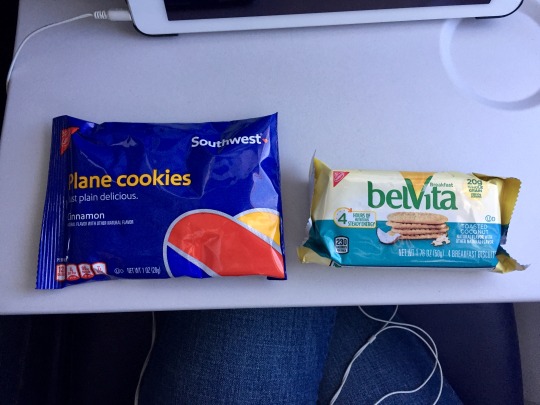
As we flew over the Sierras, we had beautiful views of snow-capped mountains through light puffy clouds.


As we made our way further east, the views changed to endless farms and crop fields as far as the eye could see. I passed the time by watching the new season of 13 Reasons Why on my iPad, and before I knew it, we could see the Chicago skyline in the distance. We sat on the right side of the plane (when facing the front), and had beautiful views of the city and Lake Michigan as we made our final descent into Midway Airport.
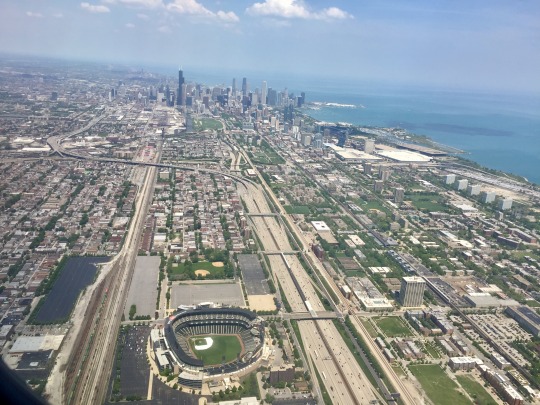

We landed a few minutes early at 12:30pm local time, but we had to wait about 10 minutes for our gate to open up. Midway is a nice, small, convenient airport, and we easily found our way down to the L train station. It did take a few minutes to walk down all of the corridors, but once we found our way, it was clearly labeled. We bought one Ventra card to share because they cost $5 each but you can scan on up to 6 people at a time. L train rides cost $2.50, and bus rides cost $2.25, so we loaded $20 onto the card, knowing we planned to ride round trip to the airport and to Wrigley Field. If we needed to add more money later in the weekend, we could easily do that at any vending machine in the L train stations. The orange line ends at Midway so it only goes in one direction and you can’t get lost when boarding the train. I appreciated that even though there were 2 trains waiting, they had a sign indicating which train was next to leave so we knew which one to board.
The ride to our stop took about 25 minutes, and we exited at the Quincy stop in the Central Loop. From there, we only had to walk 2 blocks to reach our hotel. We arrived a few minutes before 2pm and our room was ready even though check in wasn’t officially until 3pm. They explained that there is complimentary coffee and snacks in the lounge downstairs (in addition to the Keurig machine in our room), and they have a complimentary wine and cheese happy hour from 5-6pm each night. We went up to our room to drop off our bags and change into shorts, and then we set off to explore the city. Just one block away, we found this huge sculpture (use the women standing below it to show the scale of its height!). We didn’t know it at the time, but later learned that this sculpture was 53 feet tall and designed to look like a flamingo.
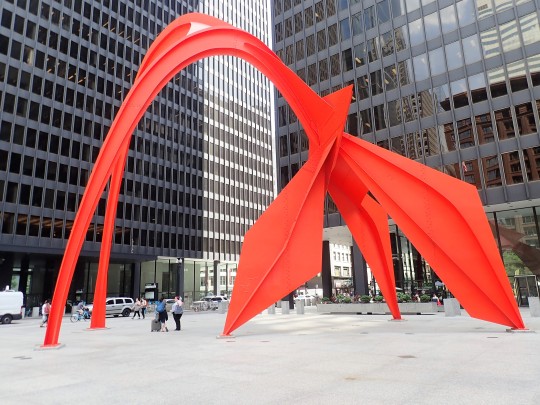
Our hotel was on Adams Street, and as we walked a few blocks east, we found a sign marking the start of Historic Route 66. I’m not sure of the exact path it travels, but I have been to the sign at the end of the route at the Santa Monica Pier in Los Angeles, so it was neat to see the starting point and know that our hotel is on the same road.

Proof that I also saw the end of the route in 2011…

From there, we walked south on Michigan Avenue, passed the Art Institute of Chicago to Grant Park. There were lots of pretty fountains, sculptures, and gardens along the way. Being a warm, sunny day on Friday of Memorial Day Weekend, the sidewalks were buzzing with lots of people out and about, enjoying the day, and it was such a great way to start our weekend here.
Dan Kiley Plaza at the Art Institute

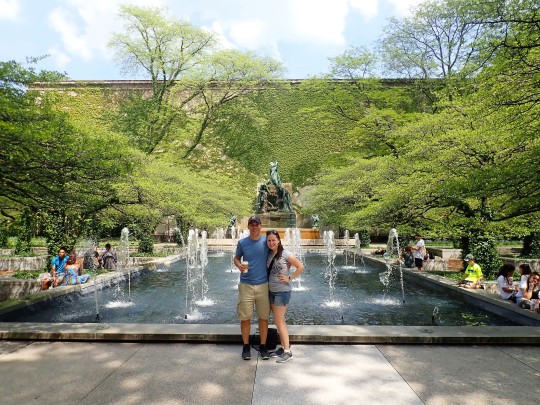
I love how the clouds reflect off the skyscrapers
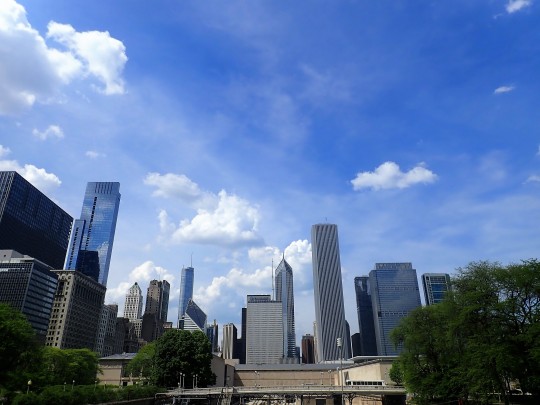
This Abraham Lincoln statue was meant to be placed in Lincoln Park, and there should have been a statue of Ulysses S. Grant in this location. Somehow things got mixed up, but it was decided to just leave this Lincoln statue here in Grant Park.

North President’s Court
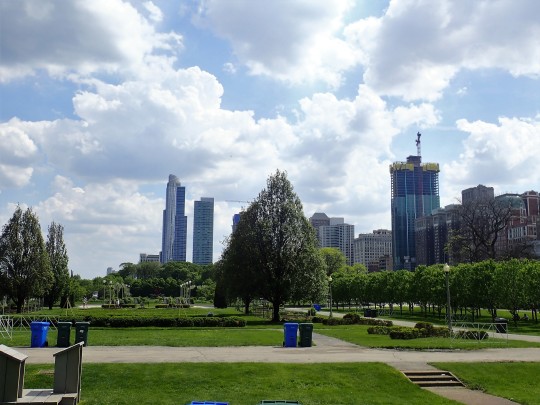
Buckingham Fountain


As we were admiring the fountain and taking photos, this happened…!
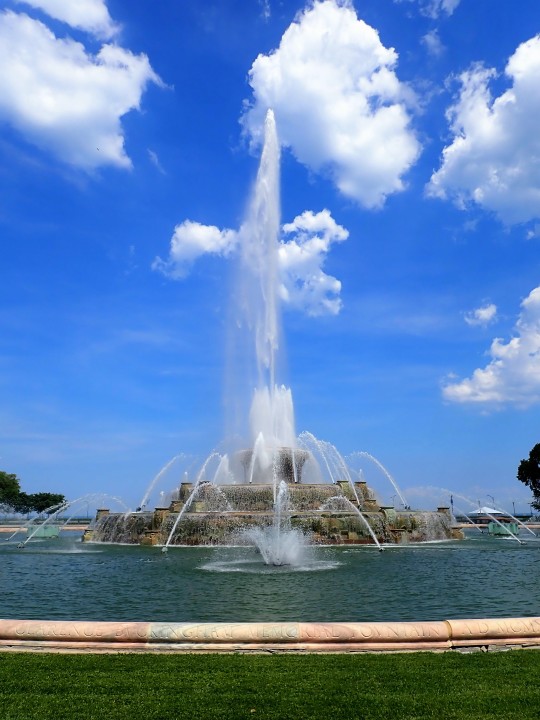
Every hour, the fountain shoots this impressive stream of water up into the sky for about 10 minutes. We could actually see the fountain going off from several other places around the city during our visit, so it was fun to see it now up close and personal.

Walking around to the opposite side of the fountain, you can see the city skyline in the background of the photo.
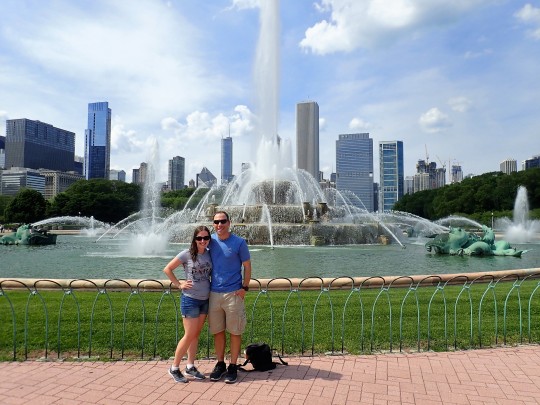
Next, we continued back north, walking from Grant Park to Millennium Park. On our way, we saw this beautiful garden. The Lurie Garden spans 5 acres within Millennium Park, and is dedicated to eco-friendly botanical landscaping.

The Jay Pritzker Pavilion is used for music festivals throughout the year

Just a short walk further and we found The Bean!! Officially called Cloud Gate, this silver bean-shaped sculpture was something I really looked forward to seeing. The sun was shining bright and the skyline looked so pretty in the reflection of the metal.
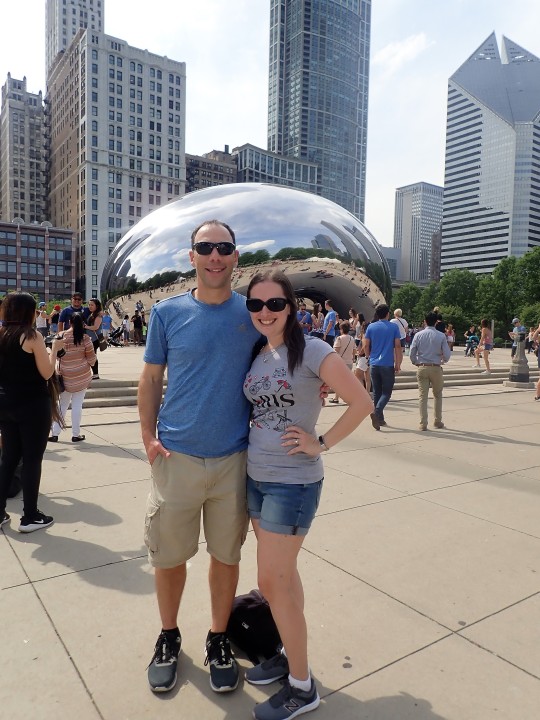
Unfortunately, we weren’t the only ones who wanted to see The Bean today, so it was super crowded and impossible to get a photo of just the statue without any other people in the photo.


Our reflection in The Bean
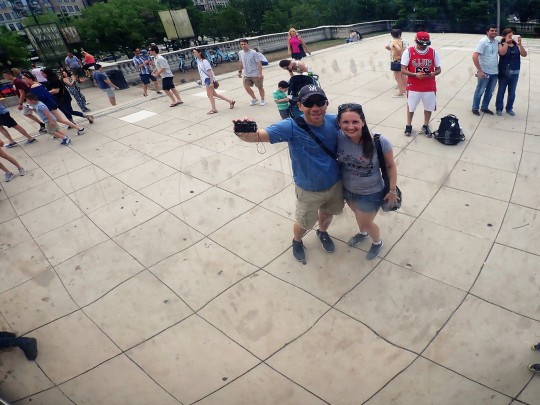


Once we had our fill of The Bean, we walked further north along Michigan Avenue until we reached the Chicago River. We’d be spending lots of time here later tonight on our walking tour, so we took a quick photo and continued on our way.

Looks like these people are having a fun Friday evening on their boats!
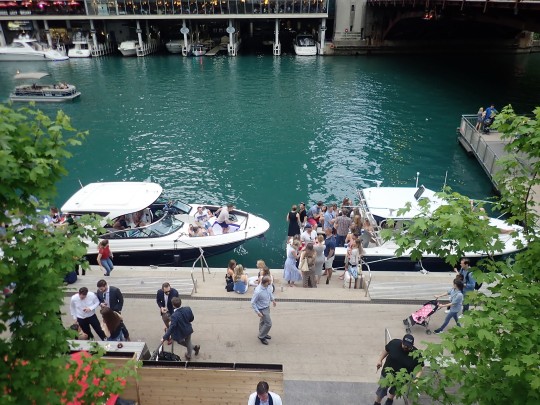
We were getting hungry since we hadn’t eaten since the sandwich we ate on the plane, so we weaved our way through the River North section to find something for dinner. One of our goals for this weekend was to eat as much deep dish pizza as possible, so why not start right away?! I tried to research the “best” restaurants for deep dish pizza in Chicago but it was nearly impossible to get a straight answer because it is so subjective. DH heard about this place called “Illuminati” that was said to have good pizza, but I couldn’t find that restaurant anywhere online. I did notice a handful of places that appeared on more than one top 10 list, including Lou Malnati’s. We both laughed when we realized he had misheard the name of that restaurant and thought it was called “Illuminati” instead! With that straightened out, we decided to eat there on our first night in town. According to reviews, this place is very popular and can have very long waits to get a table. We were scheduled to take a walking tour tonight which met at 6:45pm so we knew we had to eat an early dinner, but between the risk of a long line, and the fact that it takes 45 minutes to cook deep dish pizza, we knew we had to get to the restaurant very early. We arrived at 4:15pm and were shocked to be seated immediately! There were lots of people at the restaurant but luckily there was no wait for a table for 2.
Lou Malntai’s menu

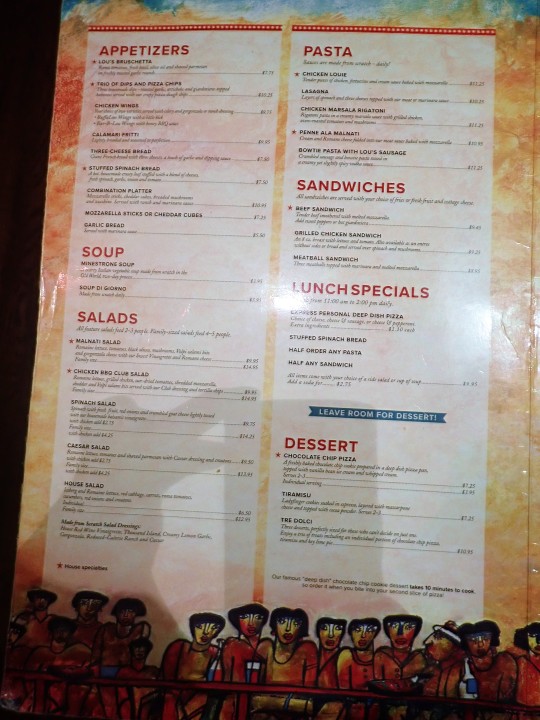

We were going to order a plain pizza, but “The Lou” caught our eye. It included a spinach mix with garlic, basil, onions, mushrooms, and sliced roma tomatoes, covered with 3 cheeses. It was nice that our waiter warned us it would take 45 to 60 minutes to cook the pizza, even though we already knew that. I can imagine if they don’t warn everyone, they must get lots of complaints from impatient people. We ordered the small, which is said to serve 2 people, and asked for the tomatoes on only one side because I don’t really like tomatoes. We passed the time catching up on social media and missed emails, and just enjoying the cool air conditioning after spending several hours walking around in the heat outside.
The pizza arrived just about an hour after we ordered. It was served in the baking pan and the waiter helped serve our first slices.



While I have never been to Chicago and therefore have never had official Chicago deep dish pizza, we do have a Chicago-style restaurant we enjoy eating at at home called Patxi, so I only had that in mind for comparison. Honestly, neither of us was blown away by this pizza. The crust had a grainy cornmeal-like consistency, and the pizza was too salty. We both thought it was just okay, as in we didn’t hate it, but we definitely didn’t love it. Maybe our standards were off and this was what Chicago pizza was supposed to taste like? We ordered the small size because the menu said that was good for 2 people. It was cut into 4 slices, and we had no trouble finishing the whole pie. We didn’t really want any leftovers considering we were not going back to the hotel anytime soon, but had there been a little more pizza or had it been a little bigger, I think we both would have eaten more. We were both satiated, but neither of us was really full.
We finished dinner by 5:45pm and had about an hour before our tour, so we started to walk back towards the Riverwalk. One thing we were not quite prepared for this weekend was the heat and humidity. It was over 90 degrees and very humid every day this weekend and ended up being Chicago’s hottest Memorial Day Weekend on record!! Instead of walking around to kill time before our tour, we went into the lobby of one of the hotels to relax and enjoy the air conditioning. While we were there, I was looking at Google maps for directions and noticed a parade route along State Street showing up on the map. I have never seen that before and I thought it was a little weird, but I clicked on it and noticed that the Memorial Day parade was on Saturday. Uh oh! We were planning to ride the Hop On Hop Off (HOHO) bus on Saturday at the same time as the parade and State Street is on the HOHO bus route. Not only that, but we were going to board at stop #3 at the Willis Tower, located just a few blocks from our hotel, and stop #2 is the Chicago Theater on State Street, so the bus wouldn’t be able to get to our stop if State Street is closed for the parade. This is so not good! I immediately went onto the website for the HOHO company Big Bus Tours, but they did not mention anything about changes or cancellations for this weekend. I tried to call their office, but it was now 6:30pm and they closed at 6pm. Too bad I didn’t catch this problem earlier in the day, but why would I know to think about that when Memorial Day isn’t until Monday? Who has a Memorial Day Parade on a Saturday?!? There is no contact email address on their website and the ‘contact us’ online form would not load on my phone, so I did not know what to do. I didn’t want to risk showing up at our HOHO stop #3 and waiting for hours but the bus never showed up because of the parade. I went onto Trip Advisor and searched their reviews for the word ‘parade’ to see how they handled this situation in the past, and luckily there was one very helpful post about the 2017 Columbus Day Parade and how the HOHO bus was a total fiasco. He said he was stuck on the bus in traffic for a long time and it was a terrible experience, and that no one should ride the bus on the day of a parade. Big Bus Tours wrote a long reply, and included an email address at the end of their post. I knew it was after hours and unlikely that I would get a reply tonight, but just in case, I sent them an email to ask about the plan for tomorrow. Our original plan was to get on the first bus which would pick us up at 9:15am. We would need to leave our hotel a few minutes after 9am at the latest to catch that bus, and their office as not due to open until 9am tomorrow. I did not expect a reply by then, but it was worth a shot. By the way, for those of you thinking “Why not just swap your Sunday plans for tomorrow?,” we panned to ride the HOHO bus on Saturday morning and get off after one full loop when we got back to the Planetarium to spend the rest of the day there. The Planetarium is 2 miles south of our hotel, so it was a little too far to walk to in this heat and it worked well to use the HOHO as free transit to the Planetarium. On Sunday, we had tickets to the Cubs game and we planned to spend some time at Wrigleyville beforehand, so it would be too rushed to do all of that on Sunday. Anyway, all of this happened at the same time as we were meeting up with our evening tour so it was really stressful. I just told myself to forget about it for the time being and to try to enjoy the tour, and I would figure out tomorrow’s plans later.
Last night, I got an email from Aram, the guide from Free Tours By Foot. He sent instructions on where and when to meet him and included his photo so we knew who he was. Right at 6:50pm, Aram arrived wearing a company logo on his shirt and holding a clip board to check us in. There were about 25 people on the tour with us. This walking tour was to point out key sites along the Riverwalk and to learn about some of Chicago’s history. Aram explained that this is a “pay what you want” tour and that we could do so at the end if we felt so inclined. The tour lasted exactly 2 hours and covered 1.5 miles, with lots of stops and photo opportunities along the way. Aram was a fantastic guide. Instead of simply rattling off facts, he told stories and explained the history and significance of the sites in a way that made it both interesting and memorable. We were very impressed with this tour and thought he was one of the best guides we have had on any tour we have ever taken! He even incorporated a bathroom break in the middle of the tour at Ghiradelli, with a chance to sample some chocolate. This is just a small sampling of the photos I took on the tour…
The Vietnam Memorial is decorated with wreaths for Memorial Day

Trump Tower Chicago is the 7th tallest building in the world. While the building itself is quite sleek, with 5 distinct levels symbolizing parts of Chicago’s history, and a nearly all glass exterior to reflect the surrounding riverfront skyline, the 2,800 square foot TRUMP sign creates a controversial eyesore. The sign was granted permits through proper proceedings, but the city council was so upset by the final product that they revamped the rules for signs on buildings in the city. Since the current Trump sign is grandfathered in, they effectively guaranteed that this eyesore will always be by far the biggest sign on a building in Chicago. Maybe they should have just left the laws as they were originally!

The Wrigley Building was built as the headquarters for the chewing gum company, and is famous for being the first major office building built north of the Chicago River. After this building opened, many other companies followed suit and it was the start of a new downtown area in Chicago.
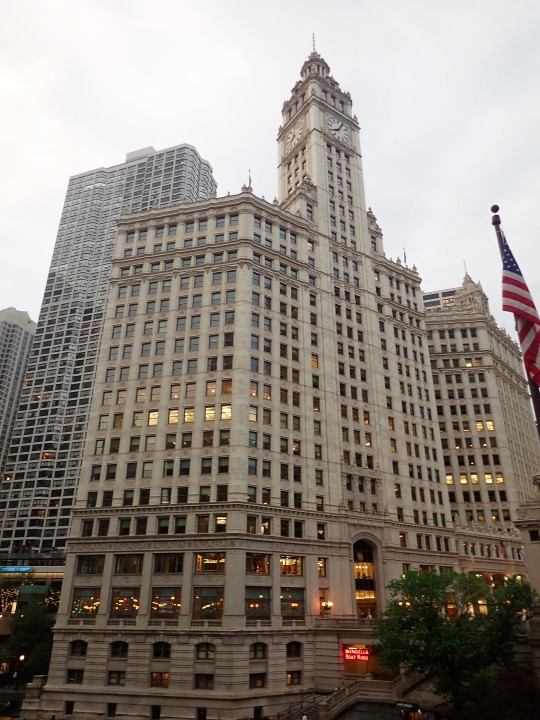

The Wrigley Building’s white glazed terra cotta façade glows beautifully in the evening light… with Trump Tower looming over in the background.
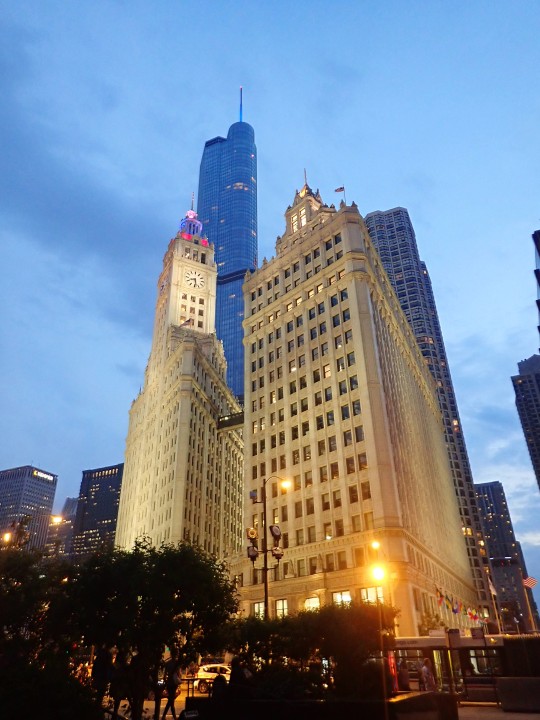
I loved how beautiful the riverwalk looked as all the lights came on at night.

The NBC Tower was built to resemble the art deco buildings of Rockefeller Center in New York.

The views grew even more beautiful as the sky darkened and the lights reflected off the water.

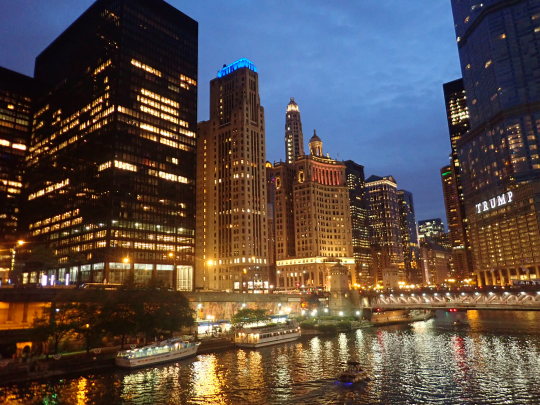
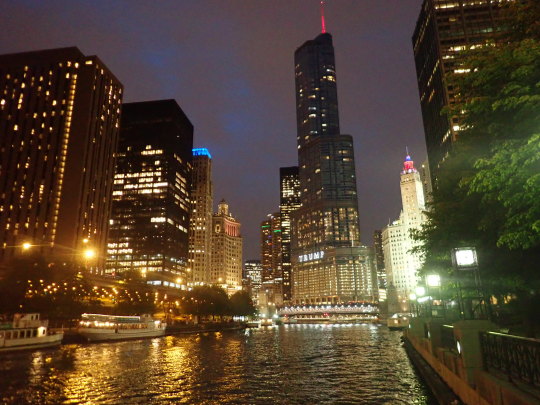
Aram timed the tour to end at exactly 9pm at the Centennial Fountain on the river so we could see the fountain go off. This happens every hour to commemorate when Chicago reversed the flow of the river’s current because the trash and sewage they had been dumping in the river was polluting Lake Michigan and their drinking water. They engineered a way to force the river to flow south and connect with the Mississippi River to send the pollution south and clean up the lake water. This was a huge turning point in Chicago’s history (even if it did annoy the people who lived down stream in St. Louis!), so they created this fountain to honor it.
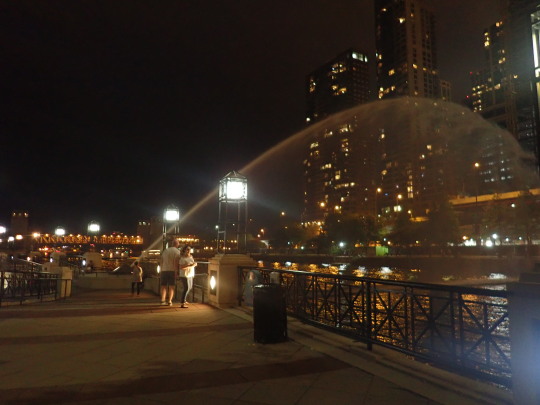
The problem is that it creates a waterfall over the river so boats need to wait for it to end before proceeding if they don’t want to get soaked haha

The Centennial Fountain
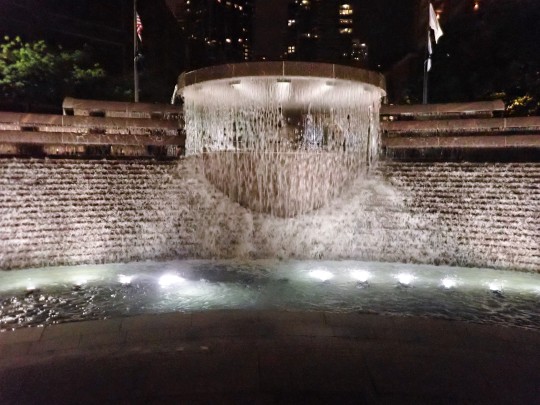

After the tour, we walked over to Navy Pier to check out what all the fuss is about. Navy Pier is listed on all of the lists of top attractions in Chicago, and all the tour guides say it’s a must-see for tourists, so since our tour ended a half mile away, we decided to walk over and check it out. When we arrived, there were lots of people leaving and hardly anyone was there. We thought this was a popular tourist attraction and expected it to be really hopping at 9:15 on a Friday night, but it was nearly deserted. We walked around to see the gardens, the carnival rides, and the nice views of the nighttime skyline, but didn’t stay long because it was dead. Maybe it is more exciting here during the day, but we did not understand the hype.
A few people were playing in the fountain, likely trying to cool off after this extremely hot and humid day!

This indoor garden is sometimes used as an event space.

We could have redeemed our City Pass to go on these rides, but decided against it.
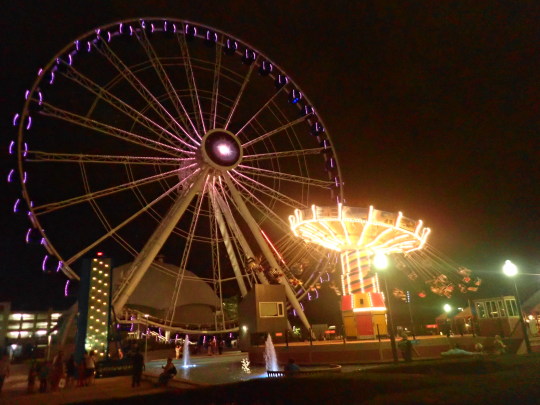
There are great views of the Chicago skyline from out on the pier.

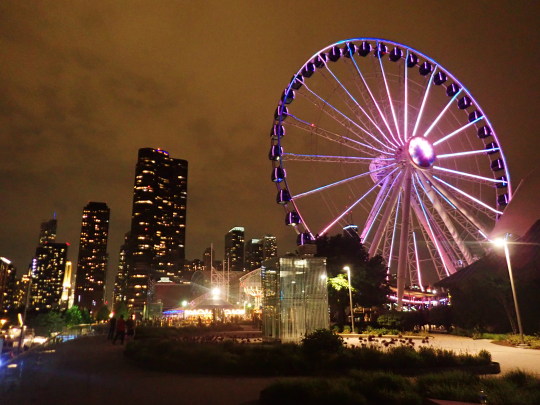
After about 15 minutes of exploring, we decided to walk back to the river walk to grab a drink at one of the outdoor bars. Navy Pier is 2 miles from our hotel, so we considered just taking an Uber to the hotel and calling it a night, but it was only 9:30 and we thought we could tough it out for 1 drink. The Riverwalk was a mile away so that would break up the long walk. Unfortunately, life does not always go according to plan. We arrived at the riverwalk around 10pm, just as the skies opened up and it started to rain. All of the bars on the Riverwalk are outdoors with no inside seating, so we had to think of a plan B. We decided to duck into the Renaissance Hotel where we had been hanging out earlier before the tour, and ordered a round of drinks at the lobby bar. This was the first chance I had to look at my phone in a few hours, and I was shocked to see an email reply from Big Bus Tours. This is what it said…
Thank you for your inquiry. As far as we know right now we will not be impacted too much during the parade. However, sometimes the city does shut down certain streets that prevents us from stopping at certain locations. If this does happen, we will adjust accordingly and signs will be posted amongst the buses as you board. We do still expect to pick up at the stop number 3 and majority of the locations along the tour.
Ummm, how can you tell me you don’t expect any problems? Surely the city will shut down State Street to vehicular traffic during the parade. This sounded like a big fiasco, so we started thinking of alternate plans. While it may be possible to take the Architectural River Tour in the morning, then take an Uber down Michigan Avenue to the Planetarium, that didn’t sound like a good idea because we wouldn’t get to the Planetarium until 12:30pm, then we’d need to eat lunch, leaving us not much time at the museum before they closed at 4pm. Instead, we decided to take a public bus from near our hotel to get to the Planetarium when they opened at 9:3am. We would spend a few hours there and eat lunch in their cafeteria, then catch the HOHO bus in the mid-afternoon. Hopefully by then, the parade would be over and traffic would be back to normal. It meant spending a little more money out of pocket to get to the museum (which should have been free with the HOHO bus), but that wasn’t a huge deal. It also meant we would be sitting outside upstairs on the HOHO bus during the peak heat of the day, instead of in the earlier morning hours as planned, and on a day with a predicated high temperature in the 90’s, we were not thrilled about that, but with the parade, this seemed like the best option.
After finishing up our beers, we made the one mile walk back to our hotel, passing the famous Chicago Theater on State Street on our way.
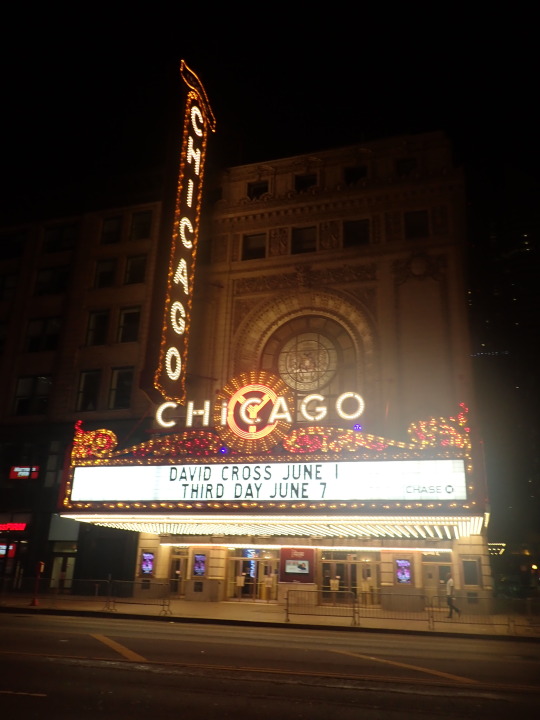
When we got back to the hotel, all we wanted to do was crash on our bed and get some sleep after an extremely long first day in Chicago. Unfortunately, that was not to be. When we checked into our room this afternoon, we were very impressed with how clean and modern it was. We were up on the 9th floor so we couldn’t hear any noise from the street, the room was very large and fairly recently renovated, and they even had a fill-your-own filtered water bottle station on each floor.

What we didn’t notice or bother to check was the pillows. OMG, these pillows were terrible!! They were very firm and way too thick, and we had no idea how anyone would find them comfortable for sleeping. After waking up at 4am, and then walking all over Chicago all day, you’d think we could sleep on a concrete slab, but after 30 minutes of laying in bed, we were both still awake. We were completely exhausted and it was nearly midnight, but neither of us could sleep. DH called down to the front desk to ask if they had softer, thinner pillows. He said he didn’t know and would ask housekeeping and they would send some up if they had it. Well that didn’t work at all because we had our ‘privacy’ door tag out for the night which said they staff would not knock on the door if displayed. We explained that and asked him to call us back after he spoke to housekeeping. Ten minutes later, he didn’t call back yet so DH called again and the guy said they don’t have any other pillows. How is that possible? Most hotels have either a small variety of pillows or a standard, generic pillow that is likely to appeal to a lot of people. This pillow was very thick and hard and likely uncomfortable for many of their guests. With no other options, I tried to get comfortable, but ultimately I was awake much more than I slept that night. DH and I planned to purchase a travel pillow tomorrow if we could find one because there was no way we would survive two more sleepless nights like this!
Step Tracker Daily Total: 23,358 steps; 9.4 miles
0 notes
Link
Finding Human
As we sidled up to a parking spot just off Wilshire Boulevard, I saw a white dog on a leash out of the corner of my eye, taking care of business, as dogs are wont to do out on public sidewalks. Opening the passenger door I got a better look at the dog, noting how her skin seemed to cling to her bones, revealing each vertebra along the spine. I then remembered the disclaimer included in all written materials about the Pierre Huyghe retrospective at LACMA: “The dog’s appearance is consistent with her breed. She has been examined by local animal safety agencies and is in excellent health.” Could this be…? Her foreleg, dyed a fluorescent pink color, confirmed it. It was Human (2012), the dog that is a work of art by Pierre Huyghe. Besides the stroke of genius luck we had in securing free street parking, we had also spotted the star of Huyghe’s show before even entering the building. An auspicious start.
Pierre Huyghe, the fifty-two-year-old French artist associated with the “relational aesthetics” set, creates films, installations, photographs, sculptures, and “live situations” often involving living creatures. At Esther Schipper Gallery in Berlin in 2011, for instance, he introduced 10,000 ants, 50 spiders, and one person carrying the flu virus into an otherwise empty gallery.
There are apparently ants and spiders in LACMA’s Resnick Pavilion, too, but they were mostly missing in action when I arrived. My partner, however, attests that he saw one ant, one single ant, poised at the opening of a hole drilled in the wall, standing there as if apprehending the grand vista beyond his humble hole-in-the-wall ant life. What luck again, that one of us happened to encounter this single ant at the moment of his sublime discovery of the wider world. Huyghe himself probably would never have imagined it.
At the outset of the exhibition stands the Name Announcer (2011), a man in a tuxedo declaring visitors’ names in turn as they enter the space. My name was uttered with such booming effect as I crossed the threshold into Huyghe’s world, it was as if the sound actually thrust me into the space. Like a reluctant skydiver given a push out of the plane, I was immediately there, no time to contemplate what was happening, the rush of the exhibition had already started. A program was thrust into my hand by another attendant at the door. “You’ll need this,” he intoned knowingly. For fear of bottlenecking the Name Announcer’s flow, I swiftly took the program and then moved to the right, where I could safely watch the first film—an 8-mm film projected on the wall, titled À Part (1986-87)—and study the exhibition program-cum-treasure map. The room is dark. Crumpled on the floor in the corner behind me there was a fur coat. Above it a poster (Or [1995]) of a hill and a path cut in twain, leading in two different directions.
Unlike your run-of-the-mill retrospective, Huyghe’s exhibition is thematically rather than chronologically ordered, and lacks labels of any kind. The program is the key to deciphering what it is you may or may not be looking at. The program also reveals the extraordinary architecture of the exhibition, as seen from above. Walls and half-walls angle jaggedly through the space, creating acute nooks and niches for discrete works of art between the open areas for viewing the video works. The exhibition operates in a set of what Huyghe calls “emergences and rhythms.” I had the distinct feeling of being pulled through the space by a kind of magnetism, attracted to a sound here and then to some sort of movement over there. With its fragmentary, almost labyrinthine layout, there was purposefully no systematic way to approach the exhibition—that instead, the visitor is meant to explore almost haphazardly. It is easy to miss things this way. But it also opens up the possibility of a sense of discovery, the kind one finds out in the natural world—a feeling that is otherwise difficult to replicate in an institutional setting, but which seems to arise naturally here. While gazing into Zoodram 5 (2011), one of the three aquarium ecosystems in the exhibition, an unexpected and sublime sightline emerged: a hermit crab inhabiting a shell shaped like the head of Brancusi’s 1910 Sleeping Muse nestled in the corner of the tank; through the glass I could see an oil painting after Modigliani on the opposite wall; overhead some neon lights flashed. It was as though art and natural history, from the primordial to the contemporary, had momentarily collapsed into one moment.
The notion of collapse or, perhaps more accurately, entropy, seems to be at work in many of Huyghe’s situations. In one of his best known works, a bee hive replaces the head of a modern statue of a female nude—the collision of a living system with inanimate stone, the collapse of life and representation. The sculpture, Untilled (Liegender Frauenakt) (2012), could be seen as an allegory of the dismantling of modernism, or even civilization itself: the eventuality of human monuments to perpetuity succumbing to the indiscriminate rhythms of nature and the deleterious effects of time. It’s neither warning nor judgment, however. Any grand statement it might suggest is buffered by its casual placement in the exhibition—set on a balcony amid three machines spewing ice, water, and vapor, it’s nearly camouflaged by its shady concrete surroundings, with water pooling around its base like so much runoff from an overtaxed air conditioning unit. I’m reminded that human values and efforts here are situated within the workings of time and nature, rather than oppositionally set apart.
But where was Human? We hadn’t seen the Ibizan hound since we spotted her outside. We were just about to leave, when I stepped beyond a curtain into a darkened room where music played to a dance performed by a smoke machine and colored lights. Behind the Light Box (2002), Human was curled up on the floor next to it. An audience was gathered. Silhouetted by the light emanating from the LED mask worn by the dog’s handler, I watched as a little girl slowly and silently approached the dog to take a photograph. The music reached a peak, then the lights went out. The masked man stood up suddenly and Human briskly followed him out of the room. As though instinctively following some primal pack impulse, the entire room stood up and filed out the door after the dog. Huyghe’s “emergences and rhythms” in action.
Five days later, like an apparition, we saw Human again, on a street corner in the Arts District of downtown LA. We turned around the block, parked, and then spotted the dog and her handler walking down the street in our direction. What luck again. We stopped and chatted for a bit. A native of Kassel, he’d met Huyghe at dOCUMENTA, and has accompanied Human to Cologne, Paris, and now Los Angeles. They will be headed to South America next, Chile I think he said. Their days off are spent exploring the city. He wondered if LACMA was too far to walk, and we assured him, yes, he should take a car. We then said goodbye, and watched as Human trotted off after him, heading west.
Review Posted on 1/5/15
0 notes
Text
9 Frank Lloyd Wright Buildings Worthy of a Road Trip
The following post is brought to you by The Frank Lloyd Wright Foundation. Our partners are handpicked by the Design Milk team because they represent the best in design.
This year marks the 150th anniversary of Frank Lloyd Wright’s birth. Everyone from designers to Frank Lloyd Wright Foundation president & CEO, Stuart Graff, have suggested that the best way to learn about the lasting impact Wright has had is to experience a Frank Lloyd Wright site in person. Considering that Wright designed more than 1,000 structures, you’d be forgiven for feeling a little overwhelmed with the possibilities. So, together with The Frank Lloyd Wright Foundation, we’ve come up with nine Frank Lloyd Wright buildings open to the public across the United States that will make you want to see more.
Ready for an architectural road trip? Although iconic buildings like Fallingwater and the Guggenheim, should certainly be on your bucket list, these picks are definitely detour worthy. We couldn’t possibly choose favorites, so the list is alphabetical. Map out your closest Frank Lloyd Wright site and get going!
AD German Warehouse \\\ Photo by Teal Tizzy Photography
What: A.D. German Warehouse
Where: Richland Center, WI
Completed: 1921
Designed by Frank Lloyd Wright in his birth town of Richland Center, WI, this impressive building has often been compared to a Mayan Temple. The only warehouse designed by Frank Lloyd Wright, this avant-garde storage space was built for a local businessman’s grocery business. It’s one of the earliest examples of a poured concrete construction, the entire 4,000 square foot building rests on a pad of cork for stability and shock absorption. Experimentation is never inexpensive, and the A.D. Warehouse was no exception. Construction was stopped, with the building unfinished in 1921 after spending $125,000, which exceeded the original cost estimate of $30,000. This year, the building celebrates its 100th birthday alongside the 150th birthday of Frank Lloyd Wright.
Front exterior of Bachman Wilson House at Crystal Bridges \\\ Photo by Nancy Nolan Photography
What: Bachman Wilson House
Where: Crystal Bridges Museum of American Art, Bentonville, Arkansas
Completed: 1956
This house is an example of the type of architecture that Frank Lloyd Wright called Usonian. He used the word to describe a New World style of building that was free from previous conventions. This house was originally built for Gloria and Abraham Wilson in 1956 along the Millstone River in New Jersey. It was subsequently purchased by architect/designer team Lawrence and Sharon Tarantino in 1988 and meticulously restored. When the house was threatened by repeated flooding at its original location, the Tarantinos determined that, in order to preserve it, they should sell the house to an institution willing to relocate it. After the Tarantinos conducted a multi-year search for a suitable institution, Crystal Bridges, an art museum in Arkansas, acquired the house in 2013. The entire structure was then taken apart and each component was labeled, packed, and moved to Arkansas, where it was reconstructed in 2015.
Charnley-Persky House East Elevation \\\ Photo by Leslie Schwartz
What: Charnley-Persky House
Where: Chicago, IL
Completed: 1892
Designed by famed Chicago architect Louis Sullivan of the firm Adler & Sullivan in 1891-1892, the the Charnley-Persky House is notable as one of the few extant buildings that display the combined talents of Louis H. Sullivan and Frank Lloyd Wright, his then-draftsman. The house embodies Sullivan’s desire to develop a new form of American architecture that would break with the past and would express new American values and ideals. Frank Lloyd Wright called it “the first modern house in America.” It would become the basis for Frank Lloyd Wright’s Prairie style and heralded a fundamental shift in architectural style.
David Wright House \\\ Photo by Andrew Pielage
What: David Wright House
Where: Phoenix, AZ
Completed: 1952
The David Wright House is regarded as one of Frank Lloyd Wright’s late-career masterpieces. Its spiral design foreshadows the Guggenheim Museum in New York. Frank Lloyd Wright noted that the views over the trees were more dramatic than those within the grove itself, so he used a single bold spiral gesture to visually pull the house towards the sky, lifting it above the treetops and away from the dusty desert floor. Wright called this home “How to Live in the Southwest.” It was designed and built of concrete blocks, wood boards, and sheet metal – common materials brought together in a lyrical composition, serving as a metaphor for the potential of American democracy when built on the shoulders of the common man. The building has not yet been recognized as a historical landmark as it was rescued from demolition by a private individual only several years ago. It was recently announced the house is being donated for the benefit of the School of Architecture at Taliesin.
Marin County Civic Center \\\ Photo by Jeff Wong
What: Marin County Civic Center
Where: San Rafael, CA
Completed: 1962
This was Frank Lloyd Wright’s last and largest public project. After the opening of the Golden Gate Bridge in 1937, the Civic Center was intended to connect Marin County and San Francisco as well as to consolidate county services. Frank Lloyd Wright was selected following a rigorous interview process that evaluated 36 architectural firms for the job. Of all the architects interviewed, only Frank Lloyd Wright saw possibilities in the hilly landscape of the site. All other architects suggested flattening them. Not only did the innovative building respond organically to the site, but it’s now also considered by historians to be one of the first public buildings to incorporate the automobile into its design. Visitors drive through the building’s arches and the parking lot is created as part of the landscape plan. And, in another nod to car culture, Frank Lloyd Wright sited the buildings so one can get a “snap shot” view from the highway driving by at 55 mph. The Civic Center is both a state and National Historic Landmark, designated in 1991.
Martin House Conservatory Interior \\\ Caitlin Deibel
What: Martin House Complex
Where: Buffalo, NY
Completed: 1905
Built for wealthy Buffalo businessman Darwin D. Martin, this residence is more than just a house, it’s a complex of six interconnected buildings. The main Martin House and a pergola that connects it to a conservatory and carriage house with chauffeur’s quarters and stables, the Barton House, a smaller residence for Martin’s sister and brother-in-law, and a gardener’s cottage added in 1909. Despite its massive size, Martin’s wife, Isabelle, was unhappy with house. She had limited sight, and the lack of natural light in the building only decreased her visibility. Despite her displeasure, this remained the family home for decades. A millionaire, Darwin was nearly wiped out by the 1929 stock market crash and following his death in 1935, the family was forced to abandon the property.
It is the most substantial and highly developed of Frank Lloyd Wright’s Prairie School style houses in the Eastern United States and received National Historic Landmark Status in 1986.
Monona Terrace
What: Monona Terrace Community and Convention Center
Where: Madison, WI
Completed: 1997; Wright’s time on the project 1938-1959
This building was a true labor of love. Frank Lloyd Wright’s first design for Monona Terrace was created in 1938. He spent 21 years, 63,000 hours of staff time, drew some 4,000 sketches and eight drafts for the project, which was finally completed in 1997, almost 40 years after his death. Although the exterior remains true to Wright’s design, the interior was reworked by a Wright protégé, Tony Puttnam.
Wright’s design plan was inspired by two key elements of the unique site: the nearby State Capitol and the waterfront. Wright’s trademark features of dramatic open spaces, strong geometric forms, and breathtaking views have made this building a Madison attraction. It still hosts more than 600 events each year.
Pope-Leighey House
What: Pope-Leighey House
Where: Alexandria, Virginia
Completed: 1939
Like the Bachman Wilson House, this is one of Frank Lloyd Wright’s Usonian homes, his concept for providing affordable, yet aesthetically pleasing, homes. Many of Frank Lloyd Wright’s innovations for the home, including spacious interiors, corner windows, and a cantilevered roof, became part of the American design vernacular. The house was built in response to a 1939 letter sent to Frank Lloyd Wright from Loren Pope, a 28-year-old copy editor for Washington, D.C.’s Evening Star newspaper. Together with his wife, Charlotte, they had just purchased a plot of land. “Dear Mr. Wright,” he wrote. “There are certain things a man wants during life, and, of life. Material things and things of the spirit. The writer has one fervent wish that includes both. It is for a house created by you.”
The budget was $5,000. Fifteen days later, Frank Lloyd Wright responded, “Of course I am ready to give you a house.” In March 1941, the couple moved into their new 1,200 square-foot, Wright-designed home.
In 1965, the house was relocated to the grounds of the 126-acre estate that was originally part of George Washington’s Mount Vernon. Today, the Pope-Leighey House is owned and operated by the National Trust for Historic Preservation.
The Westcott House. Front facade \\\ Photo by Brad Feinknopf
What: Burton and Orpha Westcott House
Where: Springfield, OH
Completed: 1908
Completed in 1908, The Westcott House is Frank Lloyd Wright’s only Prairie Style home in Ohio. Its history is a tumultuous one – shortly after WWII the house was divided into apartments and subsequently stripped of many of its original features. It served as an apartment complex for over half a century – its sleeping porches were turned into kitchens, pony stables into a shower stall, and its original garage that used to store the Westcott Car, into a game room with a pool table in the middle, right by what used to be a mechanic pit. In the 1990s the house was quickly deteriorating and, as Matt Cline, a site manager noted, the house seemed to be “held together with duct tape, bubblegum and a few prayers.” In 2005, the Westcott House underwent an inch-by-inch $5.8 million restoration. All the dramatic and unfortunate changes were reversed. The Westcott House was lucky – there were still close to 50 original drawings stored at the Frank Lloyd Wright archives and these drawings helped to bring the house back to its original glory. Today Westcott House is on the National Register of Historic Places.
To learn more about The Frank Lloyd Wright Foundation’s 150th anniversary celebration and find events near you, visit FLW150.com. You can find more public Frank Lloyd Wright sites to visit at FrankLloydWright.org/Work.
For more information about Frank Lloyd Wright and his legacy, visit FrankLloydWright.org.
via http://design-milk.com/
from WordPress https://connorrenwickblog.wordpress.com/2017/06/16/9-frank-lloyd-wright-buildings-worthy-of-a-road-trip/
0 notes